- Home
- About
- Map
- Trips
- Bringing Boat West
- Migration West
- Solo Motorcycle Ride
- Final Family XC Trip
- Colorado Rockies
- Graduates' XC Trip
- Yosemite & Nevada
- Colorado & Utah
- Best of Utah
- Southern Loop
- Pacific Northwest
- Northern Loop
- Los Angeles to NYC
- East Coast Trips
- 1 Week in Quebec
- Southeast Coast
- NH Backpacking
- Martha's Vineyard
- Canadian Maritimes
- Ocracoke Island
- Edisto Island
- First Landing '02
- Hunting Island '02
- Stowe in Winter
- Hunting Island '01
- Lake Placid
- Chesapeake
- Provincetown
- Hunting Island '00
- Acadia in Winter
- Boston Suburbs
- Niagara Falls
- First Landing '99
- Cape Hatteras
- West Coast Trips
- Mojave 4WD Course
- Colorado River Rafting
- Bishop & Death Valley
- Kauai
- Yosemite Fall
- Utah Off-Road
- Lost Coast
- Yosemite Valley
- Arizona and New Mexico
- Pescadero & Capitola
- Bishop & Death Valley
- San Diego, Anza Borrego, Joshua Tree
- Carmel
- Death Valley in Fall
- Yosemite in the Fall
- Pacific Northwest
- Utah Off-Roading
- Southern CA Deserts
- Yosemite & Covid
- Lake Powell Covid
- Eastern Sierra & Covid
- Bishop & Death Valley
- Central & SE Oregon
- Mojave Road
- Eastern Sierra
- Trinity Alps
- Tuolumne Meadows
- Lake Powell Boating
- Eastern Sierra
- Yosemite Winter
- Hawaii
- 4WD Eastern Sierra
- 4WD Death Valley +
- Southern CA Deserts
- Christmas in Tahoe
- Yosemite & Pinnacles
- Totality
- Yosemite & Sierra
- Yosemite Christmas
- Yosemite, San Diego
- Yosemite & North CA
- Seattle to Sierra
- Southwest Deserts
- Yosemite & Sierra
- Pacific Northwest
- Yosemite & South CA
- Pacific Northwest
- Northern California
- Southern Alaska
- Vancouver Island
- International Trips
- Index
- Tips
- Books
- Photos/Videos
- Search
- Contact
Malibu Beach RV Park
Wednesday, December 4, 2013 - 12:00pm by Lolo185 miles and 3.5 hours from our last stop - 2 night stay
Travelogue
 Malibu Beach RV Park SunsetIn all our travels, I would have to say that we have never had a better view from a campsite than the one we had from ours at the Malibu Beach RV Park -- and that includes the national park campgrounds as well. Surprisingly, it was only given a scenic rating of 7 in our West Coast RV Camping Guide, which now makes me somewhat skeptical about their ratings. What were they thinking? Maybe they base it totally on natural beauty, and there were a few too many mutlimillion dollar beach houses obstructing the incredible view of the ocean and shoreline, positioned in such a way that amazingly both sunrise and sunset occurred over the ocean.
Malibu Beach RV Park SunsetIn all our travels, I would have to say that we have never had a better view from a campsite than the one we had from ours at the Malibu Beach RV Park -- and that includes the national park campgrounds as well. Surprisingly, it was only given a scenic rating of 7 in our West Coast RV Camping Guide, which now makes me somewhat skeptical about their ratings. What were they thinking? Maybe they base it totally on natural beauty, and there were a few too many mutlimillion dollar beach houses obstructing the incredible view of the ocean and shoreline, positioned in such a way that amazingly both sunrise and sunset occurred over the ocean.
Also, the campground was very reasonably priced, at least off season as it was. For a partial hookup with ocean view it cost us only $40 per night -- $5 more than sites without a view. I would have paid a lot more than $5 for this view, but was certainly glad we didn’t have to.
 Lolo on Malibu Beach RunAs we often do when arriving at a new place, Herb and I set out on an exploratory run. At first we tried the Coral Canyon Trail, which started right from the campground, but the trail was so ridiculously narrow, overgrown, and steep that we quickly abandoned that idea and worked our way down to the Pacific Coast Highway with the intention of running along the beach. Not such an easy thing either, as most of Malibu Beach is privately owned, by people that very much want their privacy. However, after running for about ¾ of a mile on this way too busy road, we found a public access point and then proceeded to run along the beach, past the houses of the rich and famous, being careful to stay below the high tide line, which we figured was fair game. Property rights, we hoped, only extended to the high tide line. It was beautiful. The sun was getting low and the lighting was great. The houses weren’t too bad either, but I am always amazed when multimillion dollar houses are so close together that you can probably hear your neighbor cough. I guess the land is too valuable to waste on anything but opulent square footage.
Lolo on Malibu Beach RunAs we often do when arriving at a new place, Herb and I set out on an exploratory run. At first we tried the Coral Canyon Trail, which started right from the campground, but the trail was so ridiculously narrow, overgrown, and steep that we quickly abandoned that idea and worked our way down to the Pacific Coast Highway with the intention of running along the beach. Not such an easy thing either, as most of Malibu Beach is privately owned, by people that very much want their privacy. However, after running for about ¾ of a mile on this way too busy road, we found a public access point and then proceeded to run along the beach, past the houses of the rich and famous, being careful to stay below the high tide line, which we figured was fair game. Property rights, we hoped, only extended to the high tide line. It was beautiful. The sun was getting low and the lighting was great. The houses weren’t too bad either, but I am always amazed when multimillion dollar houses are so close together that you can probably hear your neighbor cough. I guess the land is too valuable to waste on anything but opulent square footage.
 Malibu Beach RV Park view from Lazy DazeBy the time we got back to the campsite, the sun was just dipping into the sea, but we would be here for another night, so perhaps we could get some better photos the following evening.
Malibu Beach RV Park view from Lazy DazeBy the time we got back to the campsite, the sun was just dipping into the sea, but we would be here for another night, so perhaps we could get some better photos the following evening.
One of the reasons we selected this campground, even before we knew about the view, was its proximity to the Getty Villa. As I mentioned, the weather had turned considerably colder, transforming our sunny Southern California sojourn into more of a museum tour. Not such a hardship though, as the Getty Villa and Getty Center were places we very much wanted to visit anyway.
We spent the following day visiting both (see next stop) before returning to this campground to enjoy a more leisurely sunset.
Description
Malibu Beach RV Park
 Malibu Beach RV Park Lazy Daze on BluffThe Malibu Beach RV Park is located on Highway 1 between the Malibu Pier and Paradise Cove. This lovely campground is perched atop a bluff overlooking the Pacific Ocean and the world famous Malibu Beach. Since it faces south over the ocean, both sunrise and sunset are viewable from the campground.
Malibu Beach RV Park Lazy Daze on BluffThe Malibu Beach RV Park is located on Highway 1 between the Malibu Pier and Paradise Cove. This lovely campground is perched atop a bluff overlooking the Pacific Ocean and the world famous Malibu Beach. Since it faces south over the ocean, both sunrise and sunset are viewable from the campground.
There are 140 RV sites with full or partial hookups. Other amenities include a spa, recreation room, WiFi, and cable TV.
Morro Bay State Park and San Luis Obispo
Tuesday, December 3, 2013 - 12:00pm by Lolo32 miles and 0.75 hours from our last stop - 1 night stay
Travelogue
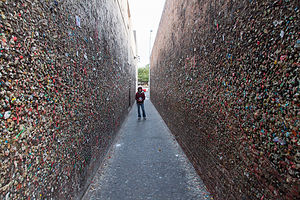 Lolo in Bubblegum AlleyThe weather had already begun to turn when we were up at Hearst Castle, but by the time we reached Morro Rock temperatures had dropped significantly and the winds were picking up, so much so that we couldn’t get out of the car to photograph the Rock without being pelted by sand—not exactly very conducive conditions for our plans of kayaking in Morro Bay.
Lolo in Bubblegum AlleyThe weather had already begun to turn when we were up at Hearst Castle, but by the time we reached Morro Rock temperatures had dropped significantly and the winds were picking up, so much so that we couldn’t get out of the car to photograph the Rock without being pelted by sand—not exactly very conducive conditions for our plans of kayaking in Morro Bay.
Part of our motivation for driving south along the coast was to get a chance to use our much neglected kayaks. The two places we had picked to use them were Morro Bay and the La Jolla Sea Caves. Needless to say, the weather was definitely not going to allow us to kayak in Morro Bay, and unfortunately, the forecast didn’t look to promising for La Jolla in a few days either. How ironic that we were able to kayak in the Russian River in Northern California last week, and were now being thwarted in Southern California. This was all feeding into Andrew and Tommy’s plan for us to eventually move to Northern California rather than Southern, where my sun-worshipping husband hoped to find a warmer climate.
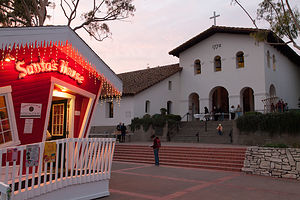 Santas House at Mission San Luis ObispoSo, instead we had to content ourselves with admiring the Rock through our sand-covered car window. It really was a very impressive rock, or more correctly a volcanic plug, known as a “morro.” In fact, there are nine morros called the Nine Sisters that form a chain between Morro Bay and San Luis Obispo. This one is the most well known and photographed though, because it stands in the entrance to the harbor, while the rest are on land. You can drive right up to this 576-foot beast over a short causeway, but you’re not allowed to climb on it because it is home to endangered peregrine falcons.
Santas House at Mission San Luis ObispoSo, instead we had to content ourselves with admiring the Rock through our sand-covered car window. It really was a very impressive rock, or more correctly a volcanic plug, known as a “morro.” In fact, there are nine morros called the Nine Sisters that form a chain between Morro Bay and San Luis Obispo. This one is the most well known and photographed though, because it stands in the entrance to the harbor, while the rest are on land. You can drive right up to this 576-foot beast over a short causeway, but you’re not allowed to climb on it because it is home to endangered peregrine falcons.
Hoping to have a better shot at it the next day, we drove into Morro Bay State Park, right near the bay, where we planned to camp for the night. When we told the ranger at the entrance booth that we had just been to Hearst Castle, he told us that the State Park employees were having their holiday party there that night. I was so envious. I mean the tour was great, but I am sure nothing compared to having the run of the place. I wonder if they get to swim in the Roman pool.
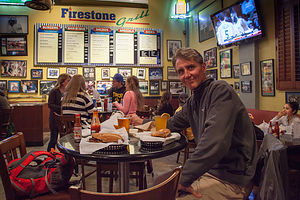 58 Year Old Herb at Firestone GrillOne of my major reasons for stopping here, other than the hope of kayaking, was to see the nearby town of San Luis Obispo, which we had heard so many good things about. Herb and I will eventually move to the West Coast and we are always on the lookout for possible places to live. A college town is pretty much a must for us, for the culture and liveliness, so Cal Poly put this one in the running.
58 Year Old Herb at Firestone GrillOne of my major reasons for stopping here, other than the hope of kayaking, was to see the nearby town of San Luis Obispo, which we had heard so many good things about. Herb and I will eventually move to the West Coast and we are always on the lookout for possible places to live. A college town is pretty much a must for us, for the culture and liveliness, so Cal Poly put this one in the running.
As we always do when exploring a new place, we consulted our guidebooks and came up with a few things we’d like to see – in this case, the Mission San Luis Obispo de Tolosa and Bubblegum Alley, which admittedly fell on opposite ends of the cultural and historical significance spectrum. Since our visit to Seattle’s Bubblegum Alley, I have changed my view of this form of public art from “Oh, gross,” to “Oh, look at how the various colors and the textures play off each other.”
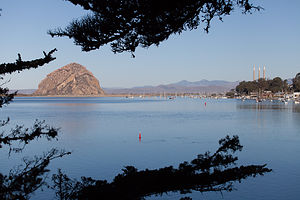 Morro Rock with SmokestacksWe thought finding the Alley might be tough, but ironically, after searching for parking, we finally found a spot on Higuera Street, literally right in front of it. There certainly was a lot of chewed gum on display in this 15 foot high, 70 foot long alley. I wonder how many cavities it is responsible for.
Morro Rock with SmokestacksWe thought finding the Alley might be tough, but ironically, after searching for parking, we finally found a spot on Higuera Street, literally right in front of it. There certainly was a lot of chewed gum on display in this 15 foot high, 70 foot long alley. I wonder how many cavities it is responsible for.
Our next stop was the Mission San Luis Obispo de Tolosa, one of the string of missions established in California by the Spanish back in the late 1800s. There was plenty of activity around Mission Plaza that night, as Christmas was coming and Santa had set shop in the Plaza. Herb wanted to move on and explore the rest of the town, but I kept stalling because I wanted to hear the mission bells on the hour, and it was just a few minutes shy of 7:00.
It was so festive in the Plaza, and I was finally beginning to get in the Christmas mood, which was hard for me being so far from home and in places that had palm trees rather than Douglas firs.
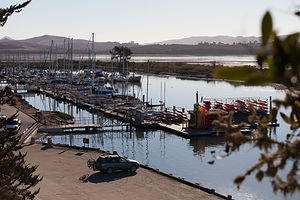 Moro Bay State Park MarinaAfter the bells, we strolled through town, taking note of the fact that it felt real and not just a tourist trap.
Moro Bay State Park MarinaAfter the bells, we strolled through town, taking note of the fact that it felt real and not just a tourist trap.
We went for dinner at the Firestone Grill for Herb’s birthday dinner, a place that had been highly recommended to us by the man who filled our propane tanks earlier in the day. The place was noisy and fun, and obviously a hangout for Cal Poly students. As per our propane man’s recommendation, we ordered the tri-tip steak sandwiches, and while we were waiting for them, I went to the bar to order us some Hefeweizen (Herb) and a Firestone IPA (me). I couldn’t believe it when the bar bill was only $5. No wonder the Cal Poly students hang out here. The tri-tip sandwich did not disappoint and we had a very fun evening.
The next morning, before continuing south, we tried once more to photograph Morro Rock. This time instead of driving out on the causeway to the base of it, we hiked the short trail from the marina up to the State Park’s Museum of Natural History on top of the hill. From here, depending on how you framed it, you could either get the pristine natural beauty of the rock rising from the waters of the bay, or swing a little to the right and include the unsightly smokestacks of the power plant rising from the shore – a very odd and incongruous partnership indeed.
Description
Morro Bay State Park
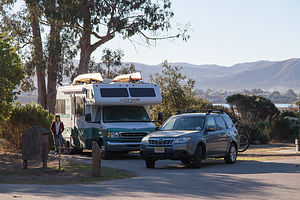 Moro Bay State Park CampgroundMorro Bay State Park is located on Morro Bay, 15 miles northwest of San Luis Obispo along scenic Highway 1. There is a 95-site campground in the park, 27 of which have partial hookups.
Moro Bay State Park CampgroundMorro Bay State Park is located on Morro Bay, 15 miles northwest of San Luis Obispo along scenic Highway 1. There is a 95-site campground in the park, 27 of which have partial hookups.
The most prominent feature in the area is Morro Rock, a 576 foot high volcanic plug that stands at the entrance to the harbor. This is one of nine “morros” or volcanic peaks that form a chain between Morro Bay and San Luis Obispo. There is a short causeway connecting the rock with the shore, but climbing on the rock itself is prohibited, because it is a reserved for the endangered peregrine falcon.
The calm waters of the bay are perfect for fishing, kayaking, and birdwatching. There are more than 15 miles of protected waters in the beautiful Morro Bay Estuary / Bird Sanctuary, which is home to California sea lions, harbor seals, sea otters, brown pelicans, and peregrine falcons.
The most popular hike in the park is to the 640-foot summit of Black Hill, one of the nine morros, from which there are spectacular views of Morro Bay and the nearby hills of Montana de Oro.
San Luis Obispo
San Luis Obispo is located at the junction of Highway 1 and US 101. Sometimes referred to as a “little Santa Barbara,” It is tucked into the mountains about halfway between Los Angeles and San Francisco.
Like many other towns and cities in California, San Luis Obispo was first established as a Spanish mission by Spanish Franciscan friars in 1772. Today the Mission San Luis Obispo de Tolosa is still an active church. The former friars’ quarters is now a small museum with artifacts from the Chumash Indians and the early Spanish settlers.
Today, the town’s main appeal is its charming, pedestrian-friendly downtown, with fine shops, galleries, and restaurants. Mission Plaza, with its brick paths and park benches along a creek, serves as the town square, often hosting festivals and concerts. During the school year the town bustles with students from California Polytechnic State University, more popularly known as Cal Poly.
San Simeon State Park and Hearst Castle
Monday, December 2, 2013 - 11:15am by Lolo239 miles and 5 hours from our last stop - 1 night stay
Travelogue
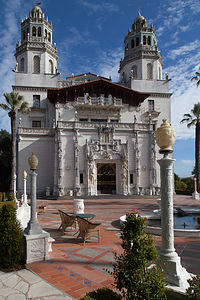 Hearst CastleNow that the boys were back to work after our wonderful Thanksgiving together in Yosemite, Herb and I were on own to explore the southern coast of California. With 9 days ahead of us before our flight back to New Jersey, we figured we would mosey on down to San Diego, making stops at interesting places along the way.
Hearst CastleNow that the boys were back to work after our wonderful Thanksgiving together in Yosemite, Herb and I were on own to explore the southern coast of California. With 9 days ahead of us before our flight back to New Jersey, we figured we would mosey on down to San Diego, making stops at interesting places along the way.
I had always wanted to see Hearst Castle, so that was first on our list. A quick consultation of our West Coast RV Camping Bible pointed us towards San Simeon State Park, just 5 miles south of Hearst Castle.
As much as I would have loved to see Monterey and Carmel again, we decided to drive down US 101 rather than Route 1 from Pacifica to San Simeon, as that section of Route 1 is a little nerve-racking in an RV. Besides, we would be back to the Bay Area so many times in the future now that Andrew lives in San Francisco that we could save that for a future trip when we could do it by car.
 Hearst Castle Great RoomSan Simeon State Park was a great find, not just because of its proximity to the Castle, but because it was beautiful in its own right. There are two campgrounds to choose from in the park – one just across the road from the beach that has showers and costs $35 a night, and the Washburn Primitive Campground, a mile further inland on the top of a plateau overlooking the ocean and the Santa Lucia Mountains, with no showers for $20 a night. We chose Washburn, not for the $15 savings, but because of the views, and the fact that there was a trail to run on right from the campground to the beach.
Hearst Castle Great RoomSan Simeon State Park was a great find, not just because of its proximity to the Castle, but because it was beautiful in its own right. There are two campgrounds to choose from in the park – one just across the road from the beach that has showers and costs $35 a night, and the Washburn Primitive Campground, a mile further inland on the top of a plateau overlooking the ocean and the Santa Lucia Mountains, with no showers for $20 a night. We chose Washburn, not for the $15 savings, but because of the views, and the fact that there was a trail to run on right from the campground to the beach.
 Hearst Castle Dining RoomWith the days so short this time of year, we really had to get all outdoor activities in my 4:30 or 5:00, which was really pretty annoying. So, we quickly got on our running clothes and headed out on the San Simeon Creek Trail, which led us from our nice Monterey pine covered ridge down a steep trail along the creek to a boardwalk across a wetland and out to the beach. Once on the beach, we ran south for awhile before making the steep climb back through the forest. We arrived back at our campsite just in time to watch the sun dip behind the mountains.
Hearst Castle Dining RoomWith the days so short this time of year, we really had to get all outdoor activities in my 4:30 or 5:00, which was really pretty annoying. So, we quickly got on our running clothes and headed out on the San Simeon Creek Trail, which led us from our nice Monterey pine covered ridge down a steep trail along the creek to a boardwalk across a wetland and out to the beach. Once on the beach, we ran south for awhile before making the steep climb back through the forest. We arrived back at our campsite just in time to watch the sun dip behind the mountains.
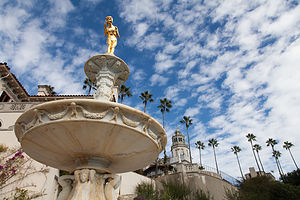 Hearst Castle Gold Girl in FountainThe next morning we were off to Hearst Castle for our 10:00 tour, which we had booked online the previous day – a smart thing to do because of the extreme popularity of these tours, which often book up days in advance. There are three different tours offered: the Grand Rooms, the Upstairs Suites, and the Cottages and Kitchens. We chose the Grand Rooms, the one recommended for first time visitors. However, we did notice that several of our fellow tourists had booked multiple tours, which wasn’t a bad idea. There’s also an Evening Tour where docents dress up in period costumes and make you feel that you are a guest at the castle. That one sounded really cool, but Herb wanted to photograph the Castle during the day – perhaps, next time.
Hearst Castle Gold Girl in FountainThe next morning we were off to Hearst Castle for our 10:00 tour, which we had booked online the previous day – a smart thing to do because of the extreme popularity of these tours, which often book up days in advance. There are three different tours offered: the Grand Rooms, the Upstairs Suites, and the Cottages and Kitchens. We chose the Grand Rooms, the one recommended for first time visitors. However, we did notice that several of our fellow tourists had booked multiple tours, which wasn’t a bad idea. There’s also an Evening Tour where docents dress up in period costumes and make you feel that you are a guest at the castle. That one sounded really cool, but Herb wanted to photograph the Castle during the day – perhaps, next time.
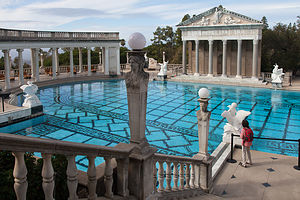 Hearst Castle Neptune Pool EntranceWe had about a ½ to kill before our tour, so we explored the very informative exhibits in the Visitor Center where we learned a great deal about the man himself, William Randolph Hearst, as well as about the history of his castle. Good, I felt prepped for my tour.
Hearst Castle Neptune Pool EntranceWe had about a ½ to kill before our tour, so we explored the very informative exhibits in the Visitor Center where we learned a great deal about the man himself, William Randolph Hearst, as well as about the history of his castle. Good, I felt prepped for my tour.
Without giving everything away, the following is a very brief summary of its history:
Back in 1865, William Randolph Hearst’s father George purchased 40,000 acres of ranchland in San Simeon, which eventually grew to 250,000 acres by the time of his death in 1919. William, a wealthy man in his own right from his vast publishing empire, inherited the land and immediately began dreaming of transforming it into a retreat. For its location, he chose the solitary top of a hill, which he named la Cuesta Encantada, the Enchanted Hill. For 30 years and $25 million, Hearst and his architect Julia Morgan worked on designing what you see today – the 115-room, Mediterranean Revival style Castle and its surrounding 127 acres of gardens, terraces, pools, and walkways. Plus, three guest "cottages." The design also incorporated his extensive art collection, much of which is on display both in the mansion as well as in the surrounding gardens and terraces. During the 1920s and 1930s, this opulent estate became a gathering place for many Hollywood and political elites, such as Cary Grant, James Stewart, Bob Hope, Charlie Chaplin, the Marx Brothers, Franklin Roosevelt, Calvin Coolidge, Winston Churchill, and more. In 1957, the Hearst family donated the estate to the state of California, and that is why we are fortunate enough to be one of Hearst’s guests today.
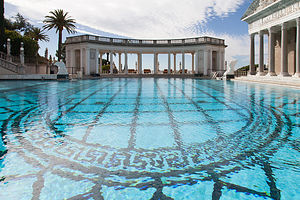 Hearst Castle Neptune PoolOkay, now that we are all up to speed somewhat, it’s time to join the bus for an incredible five-mile steep and windy journey up to the Castle atop the Enchanted Hill. As far as I was concerned, this ride was already worth my $25 price of admission. The views of the castle, the San Lucia Mountains, and the Pacific Ocean were breathtaking. An audio narration by Alex Trebek added to the trip as well.
Hearst Castle Neptune PoolOkay, now that we are all up to speed somewhat, it’s time to join the bus for an incredible five-mile steep and windy journey up to the Castle atop the Enchanted Hill. As far as I was concerned, this ride was already worth my $25 price of admission. The views of the castle, the San Lucia Mountains, and the Pacific Ocean were breathtaking. An audio narration by Alex Trebek added to the trip as well.
Once atop the hill, we were greeted by our docent who would for the next 45 minutes lead us through various parts of the castle and estate, which in this tour included the Assembly Room, Refectory, Billiard Room, Theater, Gardens, Neptune Pool, and Roman Pool. Our docent was great and it seemed that his family had had some connection with William Randolph Hearst.
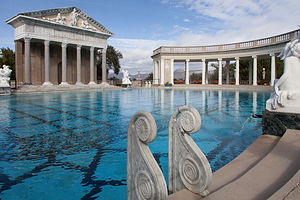 Hearst Castle Neptune PoolI absolutely love mansion tours, mostly because I like to peek into other people’s lives, especially when they are as interesting as William Randolph Hearst. The guided tour lasted 45 minutes, and then we were left to explore the estate on our own, which was probably the best part.
Hearst Castle Neptune PoolI absolutely love mansion tours, mostly because I like to peek into other people’s lives, especially when they are as interesting as William Randolph Hearst. The guided tour lasted 45 minutes, and then we were left to explore the estate on our own, which was probably the best part.
Besides the castle itself, the estate also includes three “cottages” connected by a series of terraces and walkways. Everything is relative. One man’s cottage is another man’s mansion, because these were beautiful. Each of them was named based on their view. The one facing the sea, and the largest of the group, was called Casa del Mar. The Casa del Monte faced the Santa Lucia Mountains and the Casa del Sol appropriately faced the sunset.
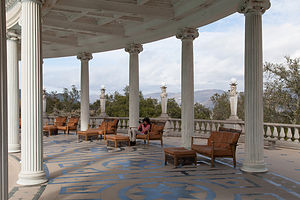 Lolo at Hearst Castle Neptune PoolProbably my highlight was the Neptune Pool. This is probably the most photographed part of the estate, and it’s easy to see why. Not only was the Greco-Roman themed pool beautiful, but the expansive views out over the mountains and ocean from its terrace were breathtaking as well. What decadence! There was even a replica of an ancient Roman temple.
Lolo at Hearst Castle Neptune PoolProbably my highlight was the Neptune Pool. This is probably the most photographed part of the estate, and it’s easy to see why. Not only was the Greco-Roman themed pool beautiful, but the expansive views out over the mountains and ocean from its terrace were breathtaking as well. What decadence! There was even a replica of an ancient Roman temple.
For those cooler days, Hearst also had an indoor pool for his guests to enjoy, modeled after the Baths of Caracalla in ancient Rome. Everyone should have one. Before seeing this, I never would have believed that an indoor pool could be so beautiful – it’s amazing what a little money can do; it’s even more amazing what a lot of money can do.
 Hearst Castle Indoor PoolThe whole effect of the design was stunning. Blue and orange glass mosaic tiles covered the walls and arches, creating a shimmering effect in the water. The roof and dome were a mosaic of night blue, with the appropriate scattering of stars, making you feel that you were looking up at a clear night sky rather than sniffing chlorine around an indoor pool in the middle of the day. To complete the effect, blue and orange alabaster-carved globe lamps emitted a glow, creating the illusion of moonlight. It really was incredible.
Hearst Castle Indoor PoolThe whole effect of the design was stunning. Blue and orange glass mosaic tiles covered the walls and arches, creating a shimmering effect in the water. The roof and dome were a mosaic of night blue, with the appropriate scattering of stars, making you feel that you were looking up at a clear night sky rather than sniffing chlorine around an indoor pool in the middle of the day. To complete the effect, blue and orange alabaster-carved globe lamps emitted a glow, creating the illusion of moonlight. It really was incredible.
One of the tour guides standing around the pool told us that on one really, really hot day, after all the tours were complete, they were allowed to jump in this pool to cool off. Now that would have been something.
Having seen all we were able to see of this incredible estate, we joined Alex Trebek for the bus ride back down the mountain.
Description
San Simeon State Park
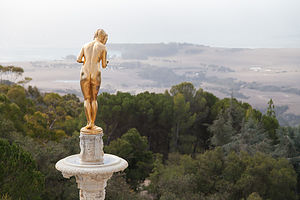 Hearst Castle OverlookSan Simeon State Park is located 35 miles north of San Luis Obispo along scenic Highway 1. Its 541 acres encompass two miles of rocky coastline, a Monterey pine forest, three natural preserves, and two campgrounds. The views inland of the Santa Lucia Mountains are spectacular. The 3.3 mile San Simeon Creek trail runs through the park from the Washburn campground, along the creek, and down to and along the beach.
Hearst Castle OverlookSan Simeon State Park is located 35 miles north of San Luis Obispo along scenic Highway 1. Its 541 acres encompass two miles of rocky coastline, a Monterey pine forest, three natural preserves, and two campgrounds. The views inland of the Santa Lucia Mountains are spectacular. The 3.3 mile San Simeon Creek trail runs through the park from the Washburn campground, along the creek, and down to and along the beach.
The park has two campgrounds set across the highway from the beach. San Simeon Creek Campground has 134 sites and the Washburn Primitive Campground has 70 sites. The Washburn Campground is located approximately one mile inland from the beach on a plateau overlooking the Santa Lucia Mountains and the ocean.
The Park’s major draw is its proximity to Hearst Castle, just 5 miles north of the campground.
Hearst Castle
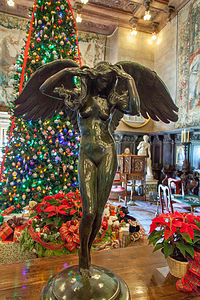 Hearst Castle at ChristmasHearst Castle is the famous 165-room estate of publishing magnate William Randolph Hearst. This magnificent “castle” sits in solitary splendor atop a hill, which Hearst named la Cuesta Encantada, the Enchanted Hill.
Hearst Castle at ChristmasHearst Castle is the famous 165-room estate of publishing magnate William Randolph Hearst. This magnificent “castle” sits in solitary splendor atop a hill, which Hearst named la Cuesta Encantada, the Enchanted Hill.
Its history began in 1865, when Hearst’s father, George Hearst, purchased 40,000 acres of ranchland. By the time of George’s death in 1919, the ranch had grown to 250,000 acres, all of which were inherited by his son William, who immediately began dreaming of ways to transform it into a retreat. For almost 30 years and $10 million, Hearst and his architect Julia Morgan, worked to create the Castle itself and 127 acres of gardens, terraces, pools, and walkways.
Hearst was very much personally involved in the estate’s design, which is a blend of Italian, Spanish, and Moorish styles. His legendary art collection, which rivals many museums, is on display both in the mansion, as well as in the gardens and terraces surrounding it.
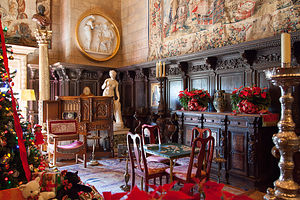 Hearst Castle Great Room DetailThe estate also includes three opulent guest houses, each focusing on a different view. Casa del Mar, the largest of the three, faces the sea, Casa del Monte looks out over the Santa Lucia Mountains, and Casa del Sol faces the sunset. The three “cottages” are connected by terraces and staircases and surrounded by gardens and sculptures.
Hearst Castle Great Room DetailThe estate also includes three opulent guest houses, each focusing on a different view. Casa del Mar, the largest of the three, faces the sea, Casa del Monte looks out over the Santa Lucia Mountains, and Casa del Sol faces the sunset. The three “cottages” are connected by terraces and staircases and surrounded by gardens and sculptures.
A highlight of the estate is the outdoor Greco-Roman Neptune Pool, perched at the edge of the hilltop, with expansive views of the mountains and sea. The pool patio features an ancient Roman temple supported by ancient Roman columns dating from the 1st to 4th century. Marble statues of Nymphs and Swans surround the pool.
There is also an indoor pool, styled after an ancient Roman bath, surrounded by eight Carrara-marble statues of Roman gods, goddesses, and heroes. The entire room is decorated with glass mosaic tiles of blue, orange, and clear fused with gold inside, creating a shimmering effect. The roof and dome are covered with mosaics of night blue, powdered with stars, while blue and orange-colored Alabaster globe lamps create the illusion of moonlight. The whole effect is breathtaking.
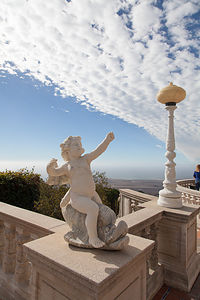 Hearst Castle CupidWith its beautiful art work, gardens, terraces, and pools, it is no wonder that an invitation to visit the Castle was highly coveted. In its heyday during the 1920s and 1930s, the Castle was the playground of many Hollywood and political elites, such as Cary Grant, James Stewart, Bob Hope, Charlie Chaplin, the Marx Brothers, Franklin Roosevelt, Calvin Coolidge, Winston Churchill, and more.
Hearst Castle CupidWith its beautiful art work, gardens, terraces, and pools, it is no wonder that an invitation to visit the Castle was highly coveted. In its heyday during the 1920s and 1930s, the Castle was the playground of many Hollywood and political elites, such as Cary Grant, James Stewart, Bob Hope, Charlie Chaplin, the Marx Brothers, Franklin Roosevelt, Calvin Coolidge, Winston Churchill, and more.
William Randolph Hearst and his Castle were also the inspiration for the 1941 movie Citizen Kane, which painted a rather unflattering picture of William Randolph Hearst. The mansion in the movie was called “Xanadu.”
In 1957, the Hearst family donated the estate to the state of California. As part of the California State Park system, it is open to the public for tours. Ticket reservations are recommended.
There are three different tours offered: Grand Rooms, Upstairs Suites, and Cottages and Kitchen. In the spring and fall, a longer Evening Tour, where docents in period costume portray Hearst’s guests, is also offered.
Tours begin at the visitor center at the foot of Enchantment Hill, where visitors can watch a 40-minute film about William Randolph Hearst’s life before riding the bus up the steep, zigzagging road to the Castle. Tours take about 2 hours, including time at the end to explore the castle grounds.
San Francisco RV Resort - Pacifica
Tuesday, November 26, 2013 - 11:00am by Lolo66 miles and 1.5 hours from our last stop - 1 night stay
Travelogue
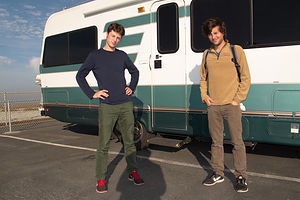 Boys at San Francisco RV ResortAt the end of our last trip, we had discovered another option for camping nearer to San Francisco than the Petaluma KOA – not a replacement though, because as far as camping goes, the Petaluma KOA is really a nicer campground, and also, that is where the motorhome is stored when we leave.
Boys at San Francisco RV ResortAt the end of our last trip, we had discovered another option for camping nearer to San Francisco than the Petaluma KOA – not a replacement though, because as far as camping goes, the Petaluma KOA is really a nicer campground, and also, that is where the motorhome is stored when we leave.
I generally don’t care for an asphalt campground, but the views of the ocean right from our campsite atop the bluff are pretty hard to beat, and it’s only 15 miles from Andrew’s apartment in the city and only 12 to the airport.
Tommy was flying into San Francisco from Seattle pretty late, so it made sense for us to stay here after picking him up at the airport, and start driving to Yosemite in the morning.
Since Tommy wasn’t coming in until 11:00, we drove into San Francisco earlier and met Andrew, Celeste, and her parents at Planet Granite, the climbing gym Herb and I have come to love. As always, it was a lot of fun, and I think Andrew and Celeste were very amused, and hopefully proud, of their mothers’ attempts on the wall.
After climbing we had a quick dinner at King of Thai Noodle, right near Andrew and Celeste’s apartment, before heading over to the airport to get Tom. Rather than come back to the city to collect Andrew in the morning, he came with us now and camped at Pacifica as well. That way we could get an early start in the morning.
That early start I mentioned didn’t exactly happen, because Andrew realized the next morning that he forgot to mail his rent check. So, rather than tow the Subaru behind the RV, Andrew and Tommy drove in the car up to San Francisco to mail the check, and Herb and I drove towards the Oakland Bay Bridge, with the plan of meeting up again in Tracy.
Description
The San Francisco RV Resort is located in the town of Pacifica, 15 miles south of Golden Gate Bridge. Besides being the closest RV camping to San Francisco, it is also one of the best RV parks in the Bay Area. Situated atop a 60-foot bluff, it is the only campground in the Bay area to offer oceanfront sites and daily dramatic sunsets.
There are 162 sites on paved, level asphalt. All sites, except the ocean sites, have full hookups and cable TV. Ocean sites have no hookups, but all campsites have free WiFi. Other amenities include a heated pool and spa, beach access, and a nearby fishing pier.
The sites range in price from $61 per night for an ocean, non hookup site, to $69 for full hookup. The campground is open all year round.
Yosemite National Park
Wednesday, November 27, 2013 - 10:15am by Lolo205 miles and 5 hours from our last stop - 4 night stay
Travelogue
 Lazy Daze at El CapitanNow that the boys were living on the West Coast and we on the East, planning holiday get-togethers was getting a bit more challenging. Since they didn’t have that much vacation time in their new jobs and the airfare around the holidays is so high, we thought it would make more sense for us to come their way, adding some vacationing on the front and back end of the holiday weekend.
Lazy Daze at El CapitanNow that the boys were living on the West Coast and we on the East, planning holiday get-togethers was getting a bit more challenging. Since they didn’t have that much vacation time in their new jobs and the airfare around the holidays is so high, we thought it would make more sense for us to come their way, adding some vacationing on the front and back end of the holiday weekend.
But where to go? I originally thought of Bend, Oregon, a halfway point between Seattle and San Francisco, and that probably would have been really great. But then, just on a whim, I went onto the Recreation.gov website and looked at campgrounds in Yosemite. I wasn’t even sure if they were open this time of year. There it was calling to me – one RV site left in the Upper Pines Campground. My heart started pounding. I didn’t really think this was going to be a possibility. I hadn’t even discussed it with the family yet. For all they knew, Thanksgiving was still going to be in New Jersey.
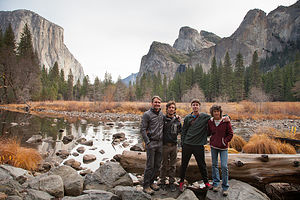 Family Photo with El CapitanFearing it would be gone if I hesitated, I grabbed the campsite and figured I would ask questions later. Any fee associated with a cancellation was well worth the possibility of doing this. There was one more obstacle to overcome before I brought the family into this plan – where to have our turkey? I had absolutely no desire to cook a Thanksgiving feast in the crowded quarters of our RV kitchen.
Family Photo with El CapitanFearing it would be gone if I hesitated, I grabbed the campsite and figured I would ask questions later. Any fee associated with a cancellation was well worth the possibility of doing this. There was one more obstacle to overcome before I brought the family into this plan – where to have our turkey? I had absolutely no desire to cook a Thanksgiving feast in the crowded quarters of our RV kitchen.
A quick search of the Yosemite website showed that there were several Thanksgiving dining options: the Ahwahnee Dining Room, the Mountain Room at Yosemite Lodge, and the Wawona Hotel. I knew the Ahwahnee would be unbelievable but very expensive, and the Wawona Hotel would be a bit too far of a drive, but I figured Yosemite Lodge would be just right. As luck would have it, the only reservation time left for 4 people was 4:00, the exact time I would have selected anyway.
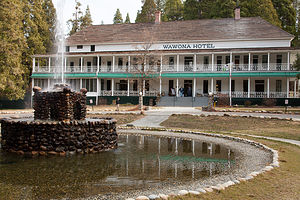 Wawona HotelThe last hurtle was clearing this idea with the family. I really wasn’t sure if the boys had their hearts set on a good old fashioned Thanksgiving at home in New Jersey. Who was I kidding? Like Herb and me, Yosemite was probably their favorite place on Earth, and I barely got the question out before receiving an enthusiastic and resounding “Yes!!” Herb, was a tiny bit more skeptical, however, as he hates the cold and didn’t know what kind of weather to expect in Yosemite in late November.
Wawona HotelThe last hurtle was clearing this idea with the family. I really wasn’t sure if the boys had their hearts set on a good old fashioned Thanksgiving at home in New Jersey. Who was I kidding? Like Herb and me, Yosemite was probably their favorite place on Earth, and I barely got the question out before receiving an enthusiastic and resounding “Yes!!” Herb, was a tiny bit more skeptical, however, as he hates the cold and didn’t know what kind of weather to expect in Yosemite in late November.
So that was how our Thanksgiving plans came to be, and now here we were, the four of us together in the motorhome once again, driving to Yosemite. Family morale was extremely high.
We arrived near dusk and, not wanting to waste a moment, quickly headed over to the Ahwahnee Meadow to watch the sun set over Half Dome. Andrew wanted to go for a run, so I went along with him on my bike – the only way I can keep up with him – while Herb and Tommy stayed behind to photograph. It was just so great to be back in the Valley again.
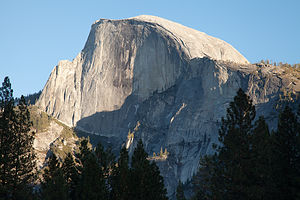 Half DomeAndrew and I decided to run/bike over to Yosemite Lodge to check out the Mountain Room, where we would be having Thanksgiving dinner the next day. The dining room wasn’t open yet, but a peek through the window satisfied our curiosity—not quite the Ahwahnee dining room, but very nice and cozy.
Half DomeAndrew and I decided to run/bike over to Yosemite Lodge to check out the Mountain Room, where we would be having Thanksgiving dinner the next day. The dining room wasn’t open yet, but a peek through the window satisfied our curiosity—not quite the Ahwahnee dining room, but very nice and cozy.
While in the Lodge, we just by chance saw a time schedule for ice skating sessions in Curry Village. I had no idea there even was ice skating in the Valley. My planning skills were slipping. Andrew and I both had the same immediate and very enthusiastic reaction. This was something we definitely had to do, and tomorrow after Thanksgiving dinner would be the perfect time to do it. We could hardly wait to get back and tell Tommy and Herb the good news. Herb was a wee bit less excited than the rest of us, but we knew he would come around when he hit the ice – hopefully figuratively and not literally.
Mariposa Grove, Thanksgiving Dinner, and Ice Skating
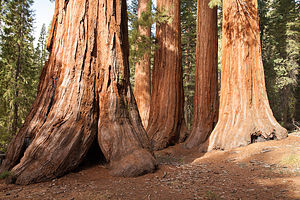 Mariposa GroveFor a different perspective on the Park, we drove down to Wawona and the Mariposa Grove of Big Trees, about 30 twisty miles south of the Valley, but not without stopping first at Tunnel View, a turnout just before the tunnel to Wawona, for the iconic and breathtaking view of El Capitan, Half Dome, and Yosemite Valley in between. It was from this spot that Herb and I got our first view of Yosemite 27 years ago, and I can still remember our awed reaction.
Mariposa GroveFor a different perspective on the Park, we drove down to Wawona and the Mariposa Grove of Big Trees, about 30 twisty miles south of the Valley, but not without stopping first at Tunnel View, a turnout just before the tunnel to Wawona, for the iconic and breathtaking view of El Capitan, Half Dome, and Yosemite Valley in between. It was from this spot that Herb and I got our first view of Yosemite 27 years ago, and I can still remember our awed reaction.
The viewpoint was busy as always, so we had to wait awhile before we could get the stone wall to ourselves to pose for the first of many attempts at the Gaidus Family 2013 Christmas Card shot.
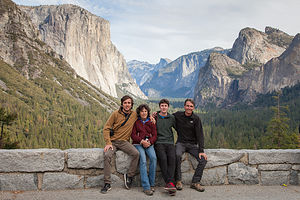 Family Photo at Tunnel ViewBefore hiking in the sequoia grove, we stopped at the historic Wawona Hotel, a lovely two-story, wooden structure that opened for business back in 1879, before Yosemite was even a park. We went inside, mostly because I wanted to peek into the dining room to visualize what their Thanksgiving dinner would be like. It was very warm and cozy and would have been an excellent choice as well.
Family Photo at Tunnel ViewBefore hiking in the sequoia grove, we stopped at the historic Wawona Hotel, a lovely two-story, wooden structure that opened for business back in 1879, before Yosemite was even a park. We went inside, mostly because I wanted to peek into the dining room to visualize what their Thanksgiving dinner would be like. It was very warm and cozy and would have been an excellent choice as well.
The main reason we drove down to Wawona, however, was to hike in the nearby Mariposa Grove, a grove of about 500 giant sequoias, many of which are more than 3,000 years old. They are considered to be the largest living things on earth – almost 300 feet tall, 50 feet in circumference, and about 2 million pounds.
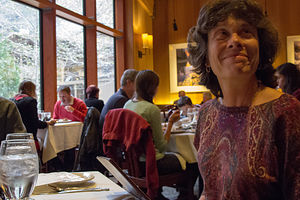 Lolo Glowing during the Mountain Room Thanksgiving DinnerThe trees are divided into a Lower and Upper Grove connected by hiking trails and a road. During the summer months an open-air tram takes tourists on the road through the grove, past many of the more famous giants. Thankfully, it wasn’t running this time of year and the only way to experience the grove was on foot. Although you can hike both groves for a total of 6 miles, we chose to just do 2.2 miles through the Lower Grove, so that we could get back in time to spend some time in the Valley before dinner. We did see some of the most famous ones, like the Fallen Monarch, the Bachelor and the Three Graces, the Grizzly Giant, the California Tunnel Tree, and my personal favorite, the Faithful Couple.
Lolo Glowing during the Mountain Room Thanksgiving DinnerThe trees are divided into a Lower and Upper Grove connected by hiking trails and a road. During the summer months an open-air tram takes tourists on the road through the grove, past many of the more famous giants. Thankfully, it wasn’t running this time of year and the only way to experience the grove was on foot. Although you can hike both groves for a total of 6 miles, we chose to just do 2.2 miles through the Lower Grove, so that we could get back in time to spend some time in the Valley before dinner. We did see some of the most famous ones, like the Fallen Monarch, the Bachelor and the Three Graces, the Grizzly Giant, the California Tunnel Tree, and my personal favorite, the Faithful Couple.
We drove back to the Valley, stopping once more at Tunnel View for another attempt at the Christmas Card shot under different lighting conditions, and then over to Yosemite Village, which is the main center for visitor services in the park. Our goal in the Village was a hot cup of coffee and then the Ansel Adams Gallery, which is run by his son Michael Adams. There are many wonderful prints on exhibit—actually they are for sale, but I treat this place more like a museum—both by Ansel Adams himself, as well as several contemporary landscape photographers.
 Ice Skating in Curry VillageAfter a quick trip back to the RV to shower and change for dinner, we drove over to the Yosemite Lodge for our Thanksgiving dinner. I must say that even if the dinner turned out to be mediocre, none of us would have regretted coming to Yosemite for Thanksgiving. Fortunately, however, that was not the case. The Mountain Room setting was cozy and warm, with wonderful views out its floor to ceiling windows, and the food, with the exception of having to send Tommy’s prime rib, which was totally raw, back for some additional cooking (that’s what he gets for not ordering turkey), was excellent as well. I was so content that I was probably glowing.
Ice Skating in Curry VillageAfter a quick trip back to the RV to shower and change for dinner, we drove over to the Yosemite Lodge for our Thanksgiving dinner. I must say that even if the dinner turned out to be mediocre, none of us would have regretted coming to Yosemite for Thanksgiving. Fortunately, however, that was not the case. The Mountain Room setting was cozy and warm, with wonderful views out its floor to ceiling windows, and the food, with the exception of having to send Tommy’s prime rib, which was totally raw, back for some additional cooking (that’s what he gets for not ordering turkey), was excellent as well. I was so content that I was probably glowing.
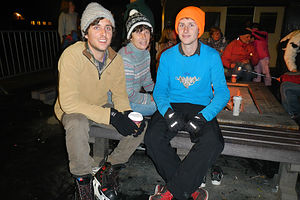 Happy Ice SkatersThe fun was not over yet though. There was still ice skating in Curry Village. If none of us broke a limb, the day would be absolutely perfect. We used to ice skate a lot when the kids were growing up, but none of us had been on skates for probably about 10 years. Let’s just say that it’s not like riding a bike. The boys regained their skills a lot quicker than Herb and I, and soon they were careening at high speed around the rink. I, however, and Herb too to some degree, kind of just shuffled awkwardly around the rink a few times before getting the hang of it again. But when we did, boy was this fun again. I had actually been pretty good in my youth and could skate backwards while doing crossovers and even spin around a little. I actually started doing this, and I would have to say I made the boys proud, and somewhat shocked as well.
Happy Ice SkatersThe fun was not over yet though. There was still ice skating in Curry Village. If none of us broke a limb, the day would be absolutely perfect. We used to ice skate a lot when the kids were growing up, but none of us had been on skates for probably about 10 years. Let’s just say that it’s not like riding a bike. The boys regained their skills a lot quicker than Herb and I, and soon they were careening at high speed around the rink. I, however, and Herb too to some degree, kind of just shuffled awkwardly around the rink a few times before getting the hang of it again. But when we did, boy was this fun again. I had actually been pretty good in my youth and could skate backwards while doing crossovers and even spin around a little. I actually started doing this, and I would have to say I made the boys proud, and somewhat shocked as well.
It had been such a wonderful day that I hated for it to end, but at least we had three more days to look forward to in the Valley.
Rock Climbing, Sentinel Beach, and Ahwahnee Bar
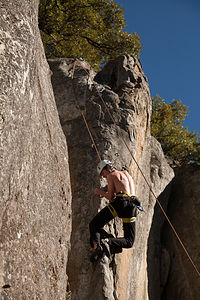 Tommy at Five and Dime WallFor avid rock climbers, such as Herb and the boys, it is difficult to come to this climbing “mecca” and not at least get on the rock a little. However, Yosemite is famous for its multi-pitch, 3,000 foot routes up granite faces such as El Cap and Half Dome, a feat that requires great technical skill, years of experience, stoutheartedness, and, in my humble opinion, a tad of insanity.
Tommy at Five and Dime WallFor avid rock climbers, such as Herb and the boys, it is difficult to come to this climbing “mecca” and not at least get on the rock a little. However, Yosemite is famous for its multi-pitch, 3,000 foot routes up granite faces such as El Cap and Half Dome, a feat that requires great technical skill, years of experience, stoutheartedness, and, in my humble opinion, a tad of insanity.
While taking on something like El Cap or Half Dome might be a long-term aspiration, this weekend they were looking for something a bit less extreme, like a short “sport” climbing route or one they could top rope. Before stumbling upon a book called “Yosemite Sport Climbs and Top Ropes,” in the Visitor Center yesterday, they didn’t know that routes like this were an option in the Valley. So thanks to that book, today they would get their chance to rock climb in Yosemite.
Tommy was in charge, because he would be the one leading the climbs, so he got to choose where to go. He chose a cliff called the Five and Dime Wall, located just north of the Valley along Route 120. It was a “sport climbing” wall, which meant that unlike “traditional” climbing where the lead climber has to put protection pieces in the rock as he climbs up to keep from falling to the ground, the bolts and protection are already there, permanently fixed to the rock. It’s a bit safer and quicker to set up a climb than “trad” climbing. They love when I use rock climbing lingo like that.
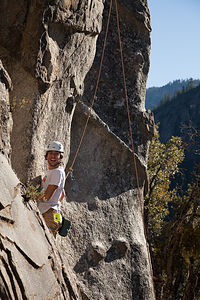 Andrew at Five and Dime WallStill though, Tommy had to lead, which meant that of the three of them, he had the greatest potential distance to fall. When you lead climb you are attached to one end of the rope and a belayer has the other end, which he feeds up to you as you move up the rock, keeping as little slack in the rope as possible, while still allowing the climber to move upwards. As you proceed up the rock, you must clip the rope into each of the pre-placed protection pieces as you get to them.
Andrew at Five and Dime WallStill though, Tommy had to lead, which meant that of the three of them, he had the greatest potential distance to fall. When you lead climb you are attached to one end of the rope and a belayer has the other end, which he feeds up to you as you move up the rock, keeping as little slack in the rope as possible, while still allowing the climber to move upwards. As you proceed up the rock, you must clip the rope into each of the pre-placed protection pieces as you get to them.
The furthest you can fall, if your belayer is good, is twice the distance from your last protection. In other words, if you climb 4 feet above your last piece of protection and fall, you will fall 8 feet and wind up 4 feet below that last piece of protection you clipped into. You always want to make sure you are not that far above the last protection that you will hit the ground if you fall.
Often, for me, the approach to the base of the climb is the equivalent of the actual climb for them. This was one of those instances. The Five and Dime Wall is located on the downhill side of Route 120, making its top just about level with the road. This meant that we had to climb down rather than up to the base. The trail was so steep that at one point I somewhat kiddingly asked if I should be roped in so they wouldn’t lose me.
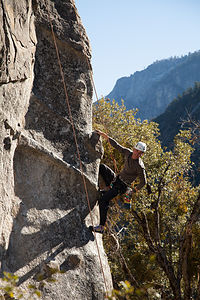 Herb at Five and Dime WallWell, we made it down to a nice flat rock at the base of the cliff, where we set up our little base camp. Oh, the other reason Tommy chose this spot to climb was that it had a southern exposure, which meant that we would be in the sun practically the whole day. This really makes a big difference in the Valley at this time of the year. In the shade, we would have needed warm jackets, but here they were actually able to climb with shorts and no shirt.
Herb at Five and Dime WallWell, we made it down to a nice flat rock at the base of the cliff, where we set up our little base camp. Oh, the other reason Tommy chose this spot to climb was that it had a southern exposure, which meant that we would be in the sun practically the whole day. This really makes a big difference in the Valley at this time of the year. In the shade, we would have needed warm jackets, but here they were actually able to climb with shorts and no shirt.
This really was beyond all expectations – challenging, but doable routes, and warm, sunny weather. I had thought that morale couldn’t possibly get any better than yesterday, but it actually did.
On our drive back into the valley, we stopped at Sentinel Beach, one of Yosemite’s nicest riverside beaches. In the summer months this is a great place to float in a tube on the Merced, gazing up at El Cap, which is probably one of my favorite things to do in the valley. It was warm today, but not quite that warm, so we spent our beach time photographing reflections of El Cap in the river.
 El Capitan Reflection in the Merced RiverHerb and the boys still wanted to climb some more, so we headed over to Camp 4, the famous rock climbers’ campground located near the base of Yosemite Falls. Over the last half century or so, the most renowned climbers in the world have used this as their base camp when climbing in Yosemite, climbers I have even heard of like Yvan Chouinard and Royal Robbins. So important was this site to the climbing community, that when its removal was threatened in the late 1990s, a campaign was started to save it. It worked, and today it is listed on the National Register of Historic Places for "its significant association with the growth and development of rock climbing in the Yosemite Valley during the 'golden years' of pioneer mountaineering.”
El Capitan Reflection in the Merced RiverHerb and the boys still wanted to climb some more, so we headed over to Camp 4, the famous rock climbers’ campground located near the base of Yosemite Falls. Over the last half century or so, the most renowned climbers in the world have used this as their base camp when climbing in Yosemite, climbers I have even heard of like Yvan Chouinard and Royal Robbins. So important was this site to the climbing community, that when its removal was threatened in the late 1990s, a campaign was started to save it. It worked, and today it is listed on the National Register of Historic Places for "its significant association with the growth and development of rock climbing in the Yosemite Valley during the 'golden years' of pioneer mountaineering.”
So here we were, on hallowed climbing ground. Even if you don’t climb, it’s fun to just walk through this camp and watch the climbing and bouldering that goes on here. Also, it was a great base camp for me, because unlike the Five and Dime Wall, there was no treacherous descent to the base. Instead, a nice flat trail ran along its base. This does, however, mean that it is a lot more crowded and you often have to wait to get on the climb you want to do.
 El Capitan and Merced RiverTommy had found a good section to top rope called Swan Slab. This was not a “sport” climb, so Tommy would have to put in his own protective pieces on the way up. However, unlike “traditional” climbing where the leader sets up a belay station on the wall from which he belays the other climbers up to him, with top roping the leader climbs up to a secure anchor point, attaches the rope, and then rapels back down, so that both ends of the rope are on the ground, secured above at the anchor point. Then one person belays from the ground as the next climber goes up the route, removing the protective pieces along the way. The reason that it is safer is that the climber can’t fall very far at all, because the belayer has him tight on the other end.
El Capitan and Merced RiverTommy had found a good section to top rope called Swan Slab. This was not a “sport” climb, so Tommy would have to put in his own protective pieces on the way up. However, unlike “traditional” climbing where the leader sets up a belay station on the wall from which he belays the other climbers up to him, with top roping the leader climbs up to a secure anchor point, attaches the rope, and then rapels back down, so that both ends of the rope are on the ground, secured above at the anchor point. Then one person belays from the ground as the next climber goes up the route, removing the protective pieces along the way. The reason that it is safer is that the climber can’t fall very far at all, because the belayer has him tight on the other end.
The Swan Slab, like all climbing walls, had dozens of routes up it with varying degrees of difficulty. That is why everyone has guide books with route descriptions and pictures where each of these routes are on the rock. For some reason, they put me in charge of the book, which I diligently studied trying to identify each of the possible routes. I must have looked somewhat knowledgeable, because several real climbers stopped to ask me if I knew what a particular route was, and surprisingly I actually did. The boys were quite amused.
However, this facade of climbing knowledge only made me look the bigger fool later. Somehow the boys had convinced me that I should climb too. While I had done a bit of climbing in the past (way, way past), I had never felt really comfortable with it and as a result had never gotten good at it. It wasn’t that I was afraid I would get hurt – I knew the belayer would have me, but still I was a bit nervous.
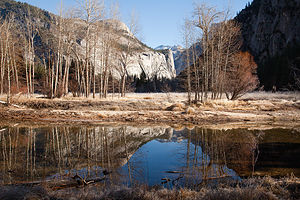 Valley Bike Loop ViewpointAs Tommy was setting up the top rope, two climbers stopped and asked if we were all going to climb the route that Tommy was starting up on. They were trying to gauge whether or not they should wait for us to finish so they could climb it afterwards. My regrettable response was, “the four of us are each going to take a run up it,” implying that I was actually a legitimate climber and knew what I was doing.
Valley Bike Loop ViewpointAs Tommy was setting up the top rope, two climbers stopped and asked if we were all going to climb the route that Tommy was starting up on. They were trying to gauge whether or not they should wait for us to finish so they could climb it afterwards. My regrettable response was, “the four of us are each going to take a run up it,” implying that I was actually a legitimate climber and knew what I was doing.
Andrew went next and quickly scaled the wall, removing Tommy’s protective pieces as he should. Then I heard the dreaded words, “Mom, you’re up next.” I somewhat skillfully tied a figure 8 knot and attached it to my harness, perpetuating the myth that I was a climber. I stared at the rock briefly seeing nothing for me to grip or step onto. “The beginning is a little tough,” Tommy said, “but once you get up about 8 feet you’ll be fine. I’ll help you.”
Famous last words. Over the next 10 minutes, I put on what was probably the most embarrassing display of climbing to every take place in Camp 4. I have to give Tommy a lot of credit for trying. Seeing me struggle to get a start, he gallantly cupped his hands for me to place a foot in to step upwards. When both my feet were off the ground, flailing madly, he placed one hand under each of my feet and tried to push me up the rock. I felt like a puppet.
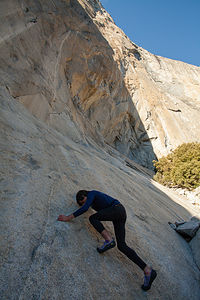 Bouldering El CapThe climax came when I actually sat on his head for a brief moment before finally hauling myself up beyond his reach. Herb and Andrew were practically rolling on the ground, and to my embarrassment, the climbers I had talked to earlier were still waiting for me to complete my “run up the rock.” I should have been mortified, but at least I was trying. I didn’t see any other 57 year old moms on the rock. The climb actually did get fun after that first part, and I was able to get up to the anchor point and be lowered down without further humiliation.
Bouldering El CapThe climax came when I actually sat on his head for a brief moment before finally hauling myself up beyond his reach. Herb and Andrew were practically rolling on the ground, and to my embarrassment, the climbers I had talked to earlier were still waiting for me to complete my “run up the rock.” I should have been mortified, but at least I was trying. I didn’t see any other 57 year old moms on the rock. The climb actually did get fun after that first part, and I was able to get up to the anchor point and be lowered down without further humiliation.
To prevent any attempts to get me to do another climb, I went off for a run around the Valley, which is not just a physical experience, but a spiritual one as well. Also, I was trying to recover my pride. I actually am a pretty decent runner.
When I got back, it was starting to get dark, but they were still going at it. When the time came for Tommy to climb up to take the top rope equipment down, it was pitch black, and he had to use a headlamp to find his way up the wall. Poor Tommy was really getting the tough stuff to do today – leading the climbs, having his mother use his head as part of the route, climbing in the dark. Everyone was appreciative though, because we wouldn’t have had such a fun day of climbing without his skill and willingness to be such a good sport.
 Lolo Bouldering with Tommy as AidThat evening, instead of cooking dinner in the RV, we headed over to the Ahwahnee Hotel to have dinner at the bar. I absolutely love national park lodges, and the Ahwahnee is one of my favorites. Herb and I stayed here with the boys when they were little, way back in 1996, and it was absolutely incredible. Now whenever we are in the park, we like to come here in the evenings to hang out in the Great Lounge. I always feel a bit self conscious doing this when I am not a hotel guest, but I saw plenty of others who I was convinced were doing the same. In fact, I don’t think the staff minds at all. I’d like to think of it as Yosemite’s living room.
Lolo Bouldering with Tommy as AidThat evening, instead of cooking dinner in the RV, we headed over to the Ahwahnee Hotel to have dinner at the bar. I absolutely love national park lodges, and the Ahwahnee is one of my favorites. Herb and I stayed here with the boys when they were little, way back in 1996, and it was absolutely incredible. Now whenever we are in the park, we like to come here in the evenings to hang out in the Great Lounge. I always feel a bit self conscious doing this when I am not a hotel guest, but I saw plenty of others who I was convinced were doing the same. In fact, I don’t think the staff minds at all. I’d like to think of it as Yosemite’s living room.
Dinner at the bar was good, much more casual and affordable than the elegant grand dining room. However, I do think that everyone should experience eating in the Ahwahnee dining room at least once during a visit to the Valley. It is an experience one will not easily forget. While the guys were finishing up at the bar, I went over to the hotel desk and made reservations for Sunday Brunch in the dining room. Lucky I did, because they were almost booked already. We thought that brunch would be a nice way to wrap up our weekend.
After dinner we found a private sitting room and played a rousing game of family hearts, where I stunned the family with my bold “shooting of the moon” on the very first round. This really was a very good day, despite my climbing debacle.
Inspiration Point, Sentinel Beach, Base of El Cap, and Ahwahnee
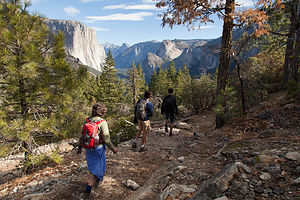 Hiking Back from Inspiration PointOver the years we have probably done most, if not all, of the hikes there are from the Valley, and although each of them is well worth repeating again and again, we wanted if possible to find something new. For some reason we had never done the hike to Inspiration Point, maybe because technically it starts just outside the Valley at the Wawona Tunnel Overlook, where we had attempted our annual Christmas photo on Thanksgiving.
Hiking Back from Inspiration PointOver the years we have probably done most, if not all, of the hikes there are from the Valley, and although each of them is well worth repeating again and again, we wanted if possible to find something new. For some reason we had never done the hike to Inspiration Point, maybe because technically it starts just outside the Valley at the Wawona Tunnel Overlook, where we had attempted our annual Christmas photo on Thanksgiving.
Although the views from the parking lot were hard to beat, it was always so crowded there, because it required absolutely no effort to get to. What we have always found is that all you have to do is hike 1 mile away from the car to lose the crowd. We figured if we hiked the 2.5-mile steep trail up to Inspiration Point, not only would we be able to more leisurely compose another attempt at the annual Christmas shot, but who knows, maybe the views could get even better.
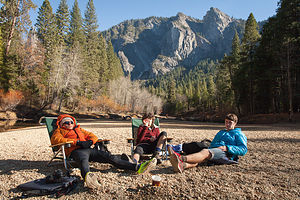 Relaxing at Sentinel BeachWe probably passed only about a dozen people, if even that many, on the trail, and when we got to the viewpoint itself, we were the only ones there. The views might not have been objectively better than those from the parking lot, but it certainly felt like they were from the solitude of this ridge.
Relaxing at Sentinel BeachWe probably passed only about a dozen people, if even that many, on the trail, and when we got to the viewpoint itself, we were the only ones there. The views might not have been objectively better than those from the parking lot, but it certainly felt like they were from the solitude of this ridge.
It was so beautiful that it seemed almost unreal, like one of those fake backdrops they put behind you in a photo studio. Without the pressure of a lineup of people waiting to stand in the same spot, we got the shot that did become our 2013 Christmas photo.
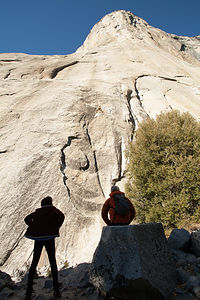 At the Base of El CapThe rest of the day, we passed leisurely in the Valley, stopping for awhile at the El Cap Meadow and then again at Sentinel Beach. We actually dragged our chairs out to the beach, but didn’t last very long. Once the sun starts to dip behind the cliffs at this time of year, the temperatures drop dramatically, and we had to put on all the layers we had. Andrew looked a little like a cross between the Michelin Man and the Great Pumpkin.
At the Base of El CapThe rest of the day, we passed leisurely in the Valley, stopping for awhile at the El Cap Meadow and then again at Sentinel Beach. We actually dragged our chairs out to the beach, but didn’t last very long. Once the sun starts to dip behind the cliffs at this time of year, the temperatures drop dramatically, and we had to put on all the layers we had. Andrew looked a little like a cross between the Michelin Man and the Great Pumpkin.
We really needed to get out in the sun, along the northern side of the Valley where the sun was still shining on the cliffs. The boys suggested a hike up to the base of El Cap to see where the classic routes up this massive face began. There was a little bit of rock scrambling to do to get there, and I think we got off trail a few times, but getting there wasn’t too bad.
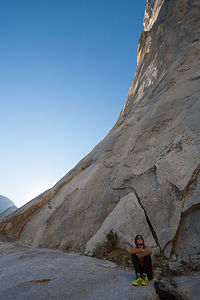 El Capitan BaseThere are few words to describe the feeling you get looking up from the base at this seemingly endless wall of granite – but awe-inspiring, breathtaking, daunting, and intimidating come to mind. We regretted not bringing climbing gear so that we could have at least climbed a little bit of El Cap, but the boys did boulder a bit at its base. Of course the family conversation turned to what it would take to get me up this entire climb, and how they would have to put me in a bag and just haul me up behind them – hahaha, very funny.
El Capitan BaseThere are few words to describe the feeling you get looking up from the base at this seemingly endless wall of granite – but awe-inspiring, breathtaking, daunting, and intimidating come to mind. We regretted not bringing climbing gear so that we could have at least climbed a little bit of El Cap, but the boys did boulder a bit at its base. Of course the family conversation turned to what it would take to get me up this entire climb, and how they would have to put me in a bag and just haul me up behind them – hahaha, very funny.
Somehow on the way back down from the base, Herb and Tommy separated from me and Andrew, and I just obliviously charged on, leading us into a field of boulders that we had to clamber over. Andrew, thinking that I had Herb in our sights, now questioned the wisdom of letting me lead. I knew we couldn’t get too lost. All we had to do was keep the big fella behind us. I was really cranky by the time we met up with Herb and Tommy on the bottom.
That night, sadly our last in Yosemite, Andrew cooked us a delicious Penne Vodka dinner in the RV. Thanks to Celeste’s training, he was becoming a very good cook, and an enthusiastic one as well. It was a pleasure watching him in the kitchen.
Afterward we went back to the Ahwahnee for one more time and sat in one of the cozy sitting rooms reading and chatting.
Ahwahnee Brunch
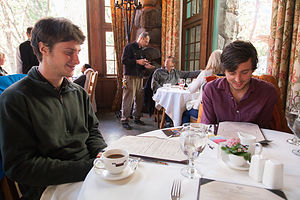 Ahwahnee BrunchWell, here it was, our last day in Yosemite. I wasn’t sure whether to be sad or ecstatic that we could still have had such a great time together. I guess I was a little of both.
Ahwahnee BrunchWell, here it was, our last day in Yosemite. I wasn’t sure whether to be sad or ecstatic that we could still have had such a great time together. I guess I was a little of both.
We still had one more classic Yosemite event left – Sunday brunch in the Ahwahnee dining room. When we got there, we requested a table in the alcove at the back of the dining room, where we had eaten on previous occasions, one of which was Tommy’s 16th birthday. So far, however, we have never been able to get the Queen’s Table, named for the fact that this is where Queen Elizabeth sat during one of her visits here. Still, no matter where you sit, you do feel a bit like royalty when dining here. The food was absolutely delicious and beautifully presented as always, but for me it’s the elegant setting and the views through the floor-to-ceiling windows that are the main attraction.
Afterwards we wandered back over to the Visitor Center and watched the national park movie about Yosemite playing in the auditorium. I think we were all just stalling, not wanting to leave just yet.
In summary, it had been what one of the boys -- I’m not sure which, but I think they both felt the same way -- described as “Our best family vacation ever,” and believe me, that’s saying a lot..
Description
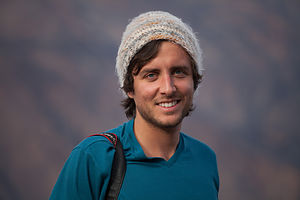 Andrew at Approach to YosemiteYosemite National Park lies near the eastern border of California in the heart of the Sierra Nevada Mountains. Its spectacular waterfalls, soaring granite cliffs, and lush meadows are just a few of the reasons it is considered by many to be nature’s ultimate masterpiece. In the words of John Muir, “it is surely the brightest and the best of all the Lord has built.”
Andrew at Approach to YosemiteYosemite National Park lies near the eastern border of California in the heart of the Sierra Nevada Mountains. Its spectacular waterfalls, soaring granite cliffs, and lush meadows are just a few of the reasons it is considered by many to be nature’s ultimate masterpiece. In the words of John Muir, “it is surely the brightest and the best of all the Lord has built.”
This description will focus on Yosemite Valley, which is the section of the park we visited. Although the Yosemite Valley is just a small portion of Yosemite’s 761,268 acres, it is part receives 95% of its visitors. In fact, an estimated 4.1 million people visit the Valley each year, making it extremely crowded.
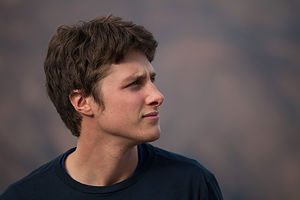 Tommy at Approach to YosemiteTwo one-way roads traverse Yosemite Valley: the east-bound Southside Drive and the west-bound Northside Drive, which wind through woodlands and meadows along the base of the 3,000-foot-high granite cliffs. As of today, cars are still allowed to enter and drive through the valley, but visitors are highly encouraged to park their vehicles and use the park’s free shuttle bus, which stops at the major attractions in the valley.
Tommy at Approach to YosemiteTwo one-way roads traverse Yosemite Valley: the east-bound Southside Drive and the west-bound Northside Drive, which wind through woodlands and meadows along the base of the 3,000-foot-high granite cliffs. As of today, cars are still allowed to enter and drive through the valley, but visitors are highly encouraged to park their vehicles and use the park’s free shuttle bus, which stops at the major attractions in the valley.
Virtual Tour of Yosemite Valley Highlights
- As you enter the valley, the first sight you’ll see is the 620-foot Bridalveil Falls flowing down from a hanging valley to the valley floor. From the parking area, a short paved path leads to the base of the falls. This is one of the few falls in Yosemite that does not completely dry up in the summer.
- Just past the Bridalveil Fall parking area, the Southside Drive begins to trace the Merced River. Soon El Capitan comes fully into view. This 3,000 foot high granite cliff is the largest single piece of exposed granite in the world and one of the most famous landmarks in Yosemite. If you look closely, you might see small dots that are actually rock climbers along its face.
- Continuing east on the Southside Drive are two riverside picnic areas and beaches: Cathedral Beach and Sentinel Beach.
- Right after the Sentinel Beach parking area is the trailhead for the 4-Mile trail, which ascends more than 3,200 feet from the valley floor to Glacier Point and one of the most spectacular views of the valley.
- A short distance further is Swinging Bridge, another picnic and swimming area. This area is also the westernmost point of the 8-mile bicycle loop that goes through the eastern part of the valley. From this point on, the bike path parallels the road.
- Next stop is the picturesque tiny Yosemite Chapel where many outdoor enthusiasts choose to exchange wedding vows.
- Now you enter the congested and developed portion of the valley.
- Right past the chapel, you can either take a left onto Sentinel Bridge towards Yosemite Village and the park exit, or you can continue straight towards Curry Village, the campgrounds, and Happy Isles Nature Center. For now, let’s stop at Sentinel Bridge for what is probably the most spectacular Half Dome viewpoint in the park. It’s a great spot for a photograph of Half Dome with the Merced River in the foreground.
- Continuing east on the Southside Drive, you pass Housekeeping Camp and Curry Village. Curry Village has lodging, restaurants, bicycle and raft rentals, a grocery store, and other shops. Curry Village is also one of the main parking areas in the valley.
- From Curry Village you can either take Northside Drive across the Ahwahnee Bridge back to Yosemite Village and the park exit, or continue east to the campgrounds. The Happy Isles Nature Center is also this way, but only shuttle buses are allowed on the road to it.
- The Happy Isles Nature Center features exhibits on the natural history of the park. It also serves as the trailhead for some of the best hikes in Yosemite. 1.5 mile trail leads to the top of Vernal Falls and then continues another 1.5 miles to the top of Nevada Falls (two waterfalls that flow even in the summer time). From there you can continue even further into the backcountry of Yosemite, including the cable route up the back of Half Dome.
- From Curry Village, the Northside Drive crosses the Ahwahnee Meadow, a wonderful spot to gaze at Half Dome during sunset, and enters Yosemite Village, the main center of visitor services in the park. Here you’ll find the park’s main Visitor Center, restaurants, lodging, shops, a grocery store, a post office, a medical clinic, the Ansel Adams Gallery, an Indian Cultural Exhibit and more. It’s also a good place to park your car and jump on the shuttle.
- A short dead end road from Yosemite Village leads to the majestic old Ahwahnee Hotel, which has played host to Queen Elizabeth, President John F. Kennedy, and Clint Eastwood, to name a few. This beautiful six-story rock structure offers tremendous views from every room. Within the hotel is the elegant and quite expensive Ahwahnee Dining Room (jackets required for dinner).
- Back on the Northside Drive heading west from Yosemite Village, the next stop is the Yosemite Falls parking area. At 2,425 feet, Yosemite Falls is the highest waterfall in North America. It is actually three waterfalls in one, with an upper, middle and lower section. A short walk from the parking lot along a paved walk leads to the base of Lower Yosemite Falls. This is the most visited landmark in the valley. Except in summer when the fall temporarily dries up, you’ll be sure to be covered in spray.
- A little further west on the Northside Drive is Yosemite Lodge, which marks the end of the developed area of the park going west.
- Right after Yosemite Lodge is Sunnyside Campground/Camp 4, a place where most rock climbers choose to congregate. From this campground begins the popular and strenuous Yosemite Falls hike, which ascends 2,600 feet from the valley floor to the top of the Upper Falls. The views from the top are incredible.
- Continuing west, there is nothing but woods and meadows from which to enjoy the views. Along the road there are several pullouts where you can stop and walk down to the Merced River for a swim. Just after the El Capitan Bridge, you’ll come to the El Capitan Meadow where you’re sure to find people looking through binoculars at the miniscule rock climbers clinging to the granite face.
- Just to the west of El Capitan, Ribbon Falls plunges over 1,600 feet down to the valley floor. It is the seventh highest waterfall in the world. However, it too dries up in the summer time.
- Finally the road nears the end of the Northside Drive at Valley View where El Capitan, on the left, and Cathedral Rocks, on the right, frame a magnificent valley view.
Several guided bus tours are also available. The 2-hour Valley Floor Tour is a great way to get acclimated. Visitors ride through the valley in an open tram while a guide leads a informative discussion of Yosemite’s history and geology. There are many photo stops along the way. In addition, there are bus tours out of the valley to Glacier Point, the Mariposa Grove of sequoia trees, and Tuolumne Meadows.
Although much of Yosemite can be enjoyed from the comforts of your car or a shuttle, the best way to truly experience Yosemite is do get out and experience it more directly..
Things to do in Yosemite
- Hike one of the many trails around the valley, ranging from an easy walk to the base of Lower Yosemite Falls to the strenuous 16-mile round trip hike up the back of Half Dome via cables
- Take an overnight backpacking trip
- Bike along the 12 miles of bicycle paths that loop through the Valley. Rentals are available at Curry Village and Yosemite Lodge.
- Rock climb in one of the premier climbing places in the world
- Raft down the calm waters of the Merced River through the valley. Rentals are available at Curry Village.
- Swim or tube in the Merced River. Besides the designated beaches, there are many pullouts along the road from which you can walk down to the river.
- Join one of the many ranger walks, which are offered daily
- Take a free art class at the Yosemite Art and Education Center
- Photograph the amazing scenery of the valley and surrounding granite cliffs
- Browse the Ansel Adams Gallery and see some of the photographs that first made Yosemite famous
- Relax in the meadow while gazing up at Half Dome or El Capitan
- Dine at the 5-star Ahwahnee Hotel, where presidents and royalty have stayed
Although many try to see Yosemite in a day, it is best to devote several days to seeing all the park has to offer. Besides the numerous hotels, lodges, and cabins in the Valley, there are three RV campgrounds: Upper Pines (238 sites), Lower Pines (60 sites), and North Pines (81 sites). That’s less than 400 campsites to accommodate all the people that want to camp here.
Since these campgrounds usually fill-up within the first hour they become available, it is essential to make your reservations as soon as possible. Campground reservations are available in blocks of one month at a time, up to five months in advance, on the 15th of each month at 7 am Pacific time. For example, if your arrival date is July 15 through August 14, the first day you can make reservations is March 15. The National Park Reservation System can be found at www.recreation.gov. Good luck!
Sebastopol and Sonoma Coast State Park
Thursday, November 21, 2013 - 10:15am by Lolo70 miles and 1.5 hours from our last stop - 5 night stay
Travelogue
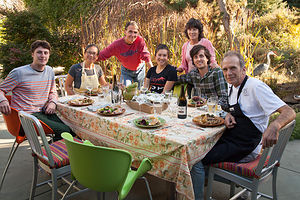 Pre-Thanksgiving FeastThe only thing better than Thanksgiving in California is two Thanksgivings in California. While the official Thanksgiving would take place in Yosemite, Celeste’s parents had invited us to a pre-Thanksgiving feast in Sebastopol the weekend before. To give you an idea of just how good a meal with the Bergs is, Tommy flew in from Seattle to join us, which doesn’t seem like that big of a deal, except for the fact that he would be flying down again in 4 days to go to Yosemite.
Pre-Thanksgiving FeastThe only thing better than Thanksgiving in California is two Thanksgivings in California. While the official Thanksgiving would take place in Yosemite, Celeste’s parents had invited us to a pre-Thanksgiving feast in Sebastopol the weekend before. To give you an idea of just how good a meal with the Bergs is, Tommy flew in from Seattle to join us, which doesn’t seem like that big of a deal, except for the fact that he would be flying down again in 4 days to go to Yosemite.
Celeste’s parents only live about 20 minutes from the Petaluma KOA where we usually live when visiting the Bay Area, but everyone thought it would be much cozier if we camped out in their driveway instead. Our only fear was whether we could get into their driveway without pulling a Lucy in the Long, Long Trailer and taking out their bushes, but Herb did a masterful job and in short order we were safely tucked into our new campsite for the weekend.
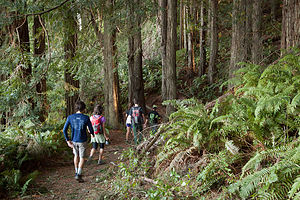 Pomo Canyon / Red Hill loop trail HikeThe Thanksgiving dinner was unbelievable and very unique for us in that we ate al fresco on their outdoor patio. This was absolutely unexpected for us. We had no idea that Northern California would be warmth enough this time of year. Moving out here eventually was definitely starting to look better and better.
Pomo Canyon / Red Hill loop trail HikeThe Thanksgiving dinner was unbelievable and very unique for us in that we ate al fresco on their outdoor patio. This was absolutely unexpected for us. We had no idea that Northern California would be warmth enough this time of year. Moving out here eventually was definitely starting to look better and better.
We originally thought we would go for a post-dinner hike, but we were all too full to move. Plus, although the weather felt like early summer, it still got dark way too early to do much outdoors after 4:00 in the afternoon. So instead, we lazied about, playing board games, eating leftovers, and just generally enjoying each other’s company.
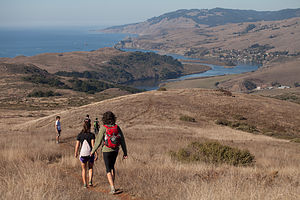 Russian River view from Red HillThe next day, however, we were rearing to go for a long hike—all but Paul who had a race with his track club. There are so many wonderful trails in Sonoma and Marin counties, most of which Hilda and Paul have already hiked, so we left the decision as to where to go in Hilda’s very capable hands. Knowing that we love the coast, she selected the Pomo Canyon / Red Hill trail, which starts from Shell Beach in the town of Jenner and climbs 1,700 feet to the top of Red Hill.
Russian River view from Red HillThe next day, however, we were rearing to go for a long hike—all but Paul who had a race with his track club. There are so many wonderful trails in Sonoma and Marin counties, most of which Hilda and Paul have already hiked, so we left the decision as to where to go in Hilda’s very capable hands. Knowing that we love the coast, she selected the Pomo Canyon / Red Hill trail, which starts from Shell Beach in the town of Jenner and climbs 1,700 feet to the top of Red Hill.
The hike was just what we were looking for – a bit of a calorie burn to counteract yesterday’s overindulgence and absolutely incredible views. For 5.5 miles we hiked through forests and grasslands to the top of Red Hill and a panoramic view of the coastline from Fort Ross to Point Reyes, the Russian River flowing into the sea, and the quaint town of Jenner.
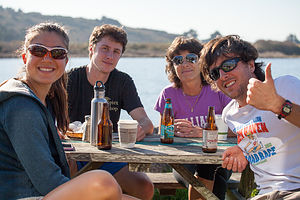 Post Hike Beers at Cafe AquaticaCeleste and Hilda mentioned there was a cute little café in Jenner, right near the mouth of the Russian River where we could get coffee and maybe even an ice cold beer. Everyone agreed this was a wonderful idea and we headed just a bit further north up Route 1 to Café Aquatica on the river. Although they didn’t serve beer, they said we were welcome to buy a six pack from across the street and drink it on their picnic table right on the river. While half the group did that—not hard to guess which half—the rest of us got coffees.
Post Hike Beers at Cafe AquaticaCeleste and Hilda mentioned there was a cute little café in Jenner, right near the mouth of the Russian River where we could get coffee and maybe even an ice cold beer. Everyone agreed this was a wonderful idea and we headed just a bit further north up Route 1 to Café Aquatica on the river. Although they didn’t serve beer, they said we were welcome to buy a six pack from across the street and drink it on their picnic table right on the river. While half the group did that—not hard to guess which half—the rest of us got coffees.
While we were sitting there, we got to talking about how nice it would be to kayak here, and how surprised we were that we would actually be able to even consider that in late November. Hilda had tried paddling once and really liked it, so she went over to the nearby kayak rental place and asked about prices and options of where to paddle. Basically, they told her that we could either go left and paddle upriver as far as we wanted to go, or go right out to the mouth where we would see a lot of seals.
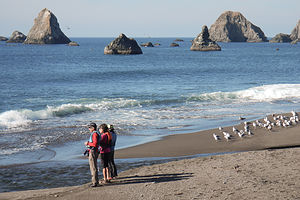 Mouth of Russian RiverSo, while sipping our beverages we came up with the plan to return the following day, Herb and I with our kayaks, and Hilda and Paul to rent them. As they listened to us plotting, the kids starting whining about how they had to go back to work while we got to just do fun stuff. Aww…I felt so bad for them.
Mouth of Russian RiverSo, while sipping our beverages we came up with the plan to return the following day, Herb and I with our kayaks, and Hilda and Paul to rent them. As they listened to us plotting, the kids starting whining about how they had to go back to work while we got to just do fun stuff. Aww…I felt so bad for them.
On the drive back, Hilda showed us two campgrounds right on the coast, Bodega Dunes and Doran Regional Park that we might want to consider as an alternative to the Petaluma KOA on future trips to the area.
That evening after the kids left to take Tommy to the airport and return to their tough working life in San Francisco, Hilda called a few more kayak rental places in Jenner and found a guy willing to rent two kayaks for $20 a piece for the whole day, much better than the $60 or $70 rates that the others were charging for a few house. He said he w ould meet us in the parking lot by Café Aquatica.
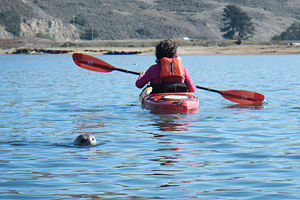 Lolo Kayaking with SealWell, you know the old saying, “you get what you pay for.” When we pulled in the lot the next morning, there was only one other vehicle there – a pickup truck with two white Perception kayaks in the back, the same short, somewhat stubby ones we bought as beginner kayaks for our boys when they were little. We were all silent for a brief moment, before Hilda and Paul went out and proudly claimed their water vessels for the day. The man told them they could keep them out for as long as they wanted and to have fun.
Lolo Kayaking with SealWell, you know the old saying, “you get what you pay for.” When we pulled in the lot the next morning, there was only one other vehicle there – a pickup truck with two white Perception kayaks in the back, the same short, somewhat stubby ones we bought as beginner kayaks for our boys when they were little. We were all silent for a brief moment, before Hilda and Paul went out and proudly claimed their water vessels for the day. The man told them they could keep them out for as long as they wanted and to have fun.
They were terrific sports about it, and the kayaks were fine for what we had in mind that day. We decided to head to the right first and paddle out to the mouth of the river, because that’s where things looked most interesting. As we meandered along, these cute little heads kept popping out of the water right next to our boats. I wasn’t sure at first whether they were seals or otters, but Hilda remembered that otters have paws while seals just have flippers. We definitely saw both that day.
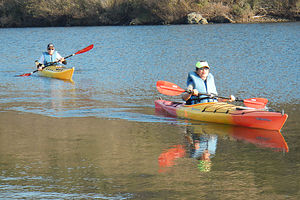 Hilda and Paul on a Test PaddleWe beached the boats on Goat Rock Beach on the southern side of the river’s mouth and walked over the sand to the ocean. The current where the river entered the sea was swift and choppy, so it was probably good that we took the kayak man’s advice and didn’t try to paddle through. Paddling out would have been quite fun and fast, but getting back in might have been a problem, especially with Hilda and Paul’s less than sleek kayaks.
Hilda and Paul on a Test PaddleWe beached the boats on Goat Rock Beach on the southern side of the river’s mouth and walked over the sand to the ocean. The current where the river entered the sea was swift and choppy, so it was probably good that we took the kayak man’s advice and didn’t try to paddle through. Paddling out would have been quite fun and fast, but getting back in might have been a problem, especially with Hilda and Paul’s less than sleek kayaks.
Afterwards we paddled back upriver, past the Café Aquatica and just past the bridge where Route 1 crossed over the river. We found a nice grassy spot to pull over for a picnic and to let Hilda and Paul try out our kayaks.
 Post Kayaking Coffee at Cafe AquaticaEventually, we paddled our way back to the parking lot where Hilda and Paul were supposed to just leave the kayaks for the rental guy to pickup later. We were surprised to find him waiting for us. “I saw you guys picnicking up by the bridge,” he said, which we found kind of creepy. “You were out so long that I came looking for you.” Probably no one had ever kept those kayaks out for more than an hour before. He didn’t know Hilda and Paul.
Post Kayaking Coffee at Cafe AquaticaEventually, we paddled our way back to the parking lot where Hilda and Paul were supposed to just leave the kayaks for the rental guy to pickup later. We were surprised to find him waiting for us. “I saw you guys picnicking up by the bridge,” he said, which we found kind of creepy. “You were out so long that I came looking for you.” Probably no one had ever kept those kayaks out for more than an hour before. He didn’t know Hilda and Paul.
We sat at our table at the Café Aquatica again, sipping coffee and talking about what a good time we had out on the river that day. I’m so glad Andrew picked a girl with such fun parents.
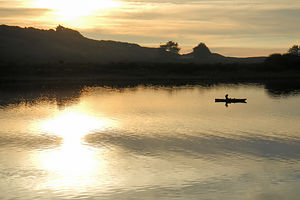 Russian River SunsetThe next morning we were to head down to our campground in Pacifica, just south of San Francisco, for the night. From there we would pick up Andrew in San Francisco and Tommy at the airport – I couldn’t believe he was flying back already – to spend the night in the RV with us and then head to Yosemite in the morning.
Russian River SunsetThe next morning we were to head down to our campground in Pacifica, just south of San Francisco, for the night. From there we would pick up Andrew in San Francisco and Tommy at the airport – I couldn’t believe he was flying back already – to spend the night in the RV with us and then head to Yosemite in the morning.
But before we left Hilda and Paul’s driveway, we had to transfer the kayaks from the roof of the Subaru back to the top of the RV, an extremely difficult task considering how heavy and awkward they are. Paul volunteered to help, but Herb said no, “Me and Lorry have to practice doing this on our own.” Famous last words. As we were lifting the kayaks off the Subaru roof racks, one of us (and according to Herb that one was me) let the kayak slip out of our hands, smashing the passenger side mirror to smithereens. Oops! Herb was none too happy about it, but remained fairly calm, probably because of Paul’s presence. No problem. We would just order a new one from Amazon –I love that site—and have it delivered to the Petaluma KOA.
We said our thank yous and goodbyes and headed out of the driveway without any further damage.
Description
Sebastopol
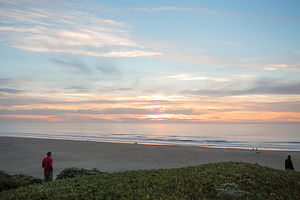 California Coast SunsetSebastopol is a charming town in Sonoma County, 52 miles north of San Francisco and about a 20-minute drive to the coast. Sebastopol is known for its apples and hosts an annual Apple Blossom Festival in April and the Gravenstein Apple Fair in August. Today, however, the apple orchards are becoming vineyards as wine-making moves more and more into the region.
California Coast SunsetSebastopol is a charming town in Sonoma County, 52 miles north of San Francisco and about a 20-minute drive to the coast. Sebastopol is known for its apples and hosts an annual Apple Blossom Festival in April and the Gravenstein Apple Fair in August. Today, however, the apple orchards are becoming vineyards as wine-making moves more and more into the region.
Every Sunday, from April to mid-December, there is a Farmers market in the downtown plaza,
where people congregate to enjoy delicious fresh regional food, live music, and dancing.
Sebastopol is home to the artist, Patrick Amiot, known for his whimsical, cartoon-like, junk-art sculptures. There are over 200 of his wacky, found-object works scattered throughout Sebastopol, especially on Florence Street.
Sonoma Coast State Park
Sonoma Coast State Park stretches for 17 gorgeous miles along Highway 1 from Bodega Bay to Goat Rock Beach in Jenner. Rugged headlands, secluded coves, and sandy beaches make this area one of California’s most scenic attractions.
The Park is actually a series of beaches separated by rocky bluffs. From several parking areas, hiking trails lead up to and along the headlands and down to secluded coves.
Some highlights include:
- Bodega Head – rocky headland that forms the entrance into Bodega Harbor. This area is very popular for hiking along the headlands and whale watching.
- Duncan’s Landing – one of the most dangerous spots along the Sonoma Coast due to large and unpredictable waves, which have swept people off the rocks
- Shell Beach – relatively calm beach that is popular for beachcombing, tidepooling, and fishing.
- Goat Rock – beach near the mouth of the Russian River in Jenner that is home to a colony of harbor seals
Flight Home
Friday, October 4, 2013 - 8:15am by Lolo55 miles and 1.5 hours from our last stop - 1 night stay
Travelogue
Time to fly back home to New Jersey once more. The only thing that made it easier leaving was knowing that we would be back in about 7 weeks to join up with the boys for Thanksgiving in Yosemite. Can't wait!!
Description
The Sonoma County Airport Express runs shuttles to the airport every hour from several locations: the Park and Ride in Santa Rosa, the Doubletree Hotel in Rohnert Park, and the Petaluma Fairgrounds. Fares are $34 each way.
San Francisco North / Petaluma KOA
Thursday, October 3, 2013 - 8:15am by Lolo50 miles and 1 hour from our last stop - 1 night stay
Travelogue
Not much to report here -- just a full day of cleaning the RV and prepping it for storage once again.
Description
The Petaluma KOA is an award winning camping resort located within an hour’s drive of San Francisco, Napa and Sonoma Valley Wineries, giant redwoods, and Sonoma County and California Coastal Beaches. It is considered to be the RV resort in the San Francisco Bay area.
On its 70 acres, there are 312 spacious RV sites, 32 camping cabins, and 10 Wine Country lodges.
Other amenities include:
• Guided tours of San Francisco (from May through October)
• Huge heated pool and spa
• Inflatable waterslide
• Rock climbing wall
• Huge playground
• Petting zoo
• Karaoke
• Hayrides and live weekend entertainment
The campground is open all year.
San Francisco RV Resort - Pacifica
Tuesday, October 1, 2013 - 8:15am by Lolo135 miles and 2.5 hours from our last stop - 2 night stay
Travelogue
 San Francisco RV Resort Sunset out of Lazy Daze Rear WindowI can’t believe I didn’t know about this place before. How did I not know that there was a campground only 15 miles from San Francisco with oceanfront sites? I was really starting to doubt myself as a trip planner. If Herb hadn't bought that book I have been raving about this entire trip -- West Coast RV Camping – I probably still wouldn't know. It gave this campground a scenic rating of 10.
San Francisco RV Resort Sunset out of Lazy Daze Rear WindowI can’t believe I didn’t know about this place before. How did I not know that there was a campground only 15 miles from San Francisco with oceanfront sites? I was really starting to doubt myself as a trip planner. If Herb hadn't bought that book I have been raving about this entire trip -- West Coast RV Camping – I probably still wouldn't know. It gave this campground a scenic rating of 10.
Now I don’t think it will be a replacement for staying at the Petaluma KOA. That’s where we store the motorhome, and it is really a much nicer campground. This one was really just an asphalt parking lot, but a parking lot with an incredible view. The oceanfront sites are perched right at the edge of a 60-foot bluff overlooking the Pacific, perfect for watching a dramatic sunset each evening from your campsite. The oceanfront sites are, however, non-hookups.
This campground is not exactly cheap either - $61 per night for an oceanfront, non-hookup site, and $69 for a full-hookup. It wasn’t the $8 savings that made us take a non-hookup, but rather that incredible view out our back window.
 Beach ViewpointThere was, however, a fence separating the campground and the trail that led along the top of the bluff, so there wasn’t really any direct access to the beach.
Beach ViewpointThere was, however, a fence separating the campground and the trail that led along the top of the bluff, so there wasn’t really any direct access to the beach.
As we often like to do when arriving in a new place for the first time, we set off on a run to explore the area. We ran along somewhat busy Palmetto Avenue for a bit before finding our way down to Beach Road and the Municipal Fishing Pier. From there, we ran alongside the beach until we came to a steep trail up to Mori Point, another one of those beautiful bluffs along the Northern California coast. However, we had already run about 2 ½ of our 5 mile run, so all we had time for now was a short run up to a viewpoint, before turning around and heading back to the campground. We would have to come back here another time by car so that we could do our entire run up on the bluffs.
Since we were so close to San Francisco, Andrew came down to visit us after work, and Celeste would be biking down later. Celeste is a very avid cycler, and she rides her bike to work at City Hall every day. She thinks nothing of a 30-mile ride up and down the hills of San Francisco and Marin after work, so riding down to Pacifica was no big deal. However, her GPS kept directing her onto busy, non-bicycle-friendly roads and it was starting to get dark, so Andrew went out with his car and rescued her along route. I felt bad because they missed a really beautiful sunset by 10 minutes.
 Lolo of Pebble Beach in PescaderoThe next day, we weren’t meeting the kids until after work, so we spent a good part of the day exploring the coast south of Pacifica. We found a great future camping destination called Pillar Point RV Park, right on Half Moon Bay. For some reason, this one was not in my book.
Lolo of Pebble Beach in PescaderoThe next day, we weren’t meeting the kids until after work, so we spent a good part of the day exploring the coast south of Pacifica. We found a great future camping destination called Pillar Point RV Park, right on Half Moon Bay. For some reason, this one was not in my book.
We continued driving south and stopped at a really pretty rocky cove at Pebble Beach in Pescadero, where the rocks are weathered to a honeycomb-like surface texture known as tafoni. They were absolutely beautiful. We could have stayed here all day photographing them.
It was a beautiful, warm day so on our way back north along Route 1, we looked for a nice beach to have lunch and sunbathe for awhile. Just north of Montaro and before the tunnel, we pulled into a parking lot for Gray Whale Cove State Beach, a beach that Herb had heard about before.
 Pebble Beach SurfWe gathered beach chairs and a cooler and headed across busy Route 1 and down a series of steep stairs to a beautiful sheltered cover surrounded by towering cliffs. If you are uncomfortable with encountering nude sunbathers, you should head to the left at the bottom of the stairs.
Pebble Beach SurfWe gathered beach chairs and a cooler and headed across busy Route 1 and down a series of steep stairs to a beautiful sheltered cover surrounded by towering cliffs. If you are uncomfortable with encountering nude sunbathers, you should head to the left at the bottom of the stairs.
The beach was lovely, and it was actually warm enough to get down to bathing suits. Its colorful cliffs reminded me a lot of Moshup Beach on Martha’s Vineyard, one of my all time favorites.
That evening we drove up to San Francisco and met Andrew and Celeste once again at Planet Granite, their climbing gym. We were back to where we started on this trip. As I mentioned in our first stop, I absolutely love this gym, both for its incredible views of the Golden Gate Bridge, Alcatraz, and the Mark di Suvero sculptures in Crissy Field, and its really fun climbing routes.
 Lolo at Gray Whale Cove State BeachAfter a good and very fun workout on the climbing walls, it was once again time to eat – one of Andrew and Celeste’s favorite pastimes. As I also mentioned earlier, Andrew and Celeste live a neighborhood with a very ethnically-diverse selection of high-quality restaurants, so the choices seem practically limitless. This time we went to Pho Garden where I had my first taste of Vietnamese food. It was wonderful and amazingly reasonable.
Lolo at Gray Whale Cove State BeachAfter a good and very fun workout on the climbing walls, it was once again time to eat – one of Andrew and Celeste’s favorite pastimes. As I also mentioned earlier, Andrew and Celeste live a neighborhood with a very ethnically-diverse selection of high-quality restaurants, so the choices seem practically limitless. This time we went to Pho Garden where I had my first taste of Vietnamese food. It was wonderful and amazingly reasonable.
This was the last time we would see Andrew and Celeste this trip, so we said our goodbyes and headed back to our campground in Pacifica. These goodbyes were getting a little easier each time, especially when we had a plan of seeing them again, which we did. We would be back in November to have a pre-Thanksgiving feast with Celeste’s family and then Thanksgiving in Yosemite with the boys. WOOHOO!!!
Description
 Beach LandscapeThe San Francisco RV Resort is located in the town of Pacifica, 15 miles south of Golden Gate Bridge. Besides being the closest RV camping to San Francisco, it is also one of the best RV parks in the Bay Area. Situated atop a 60-foot bluff, it is the only campground in the Bay area to offer oceanfront sites and daily dramatic sunsets.
Beach LandscapeThe San Francisco RV Resort is located in the town of Pacifica, 15 miles south of Golden Gate Bridge. Besides being the closest RV camping to San Francisco, it is also one of the best RV parks in the Bay Area. Situated atop a 60-foot bluff, it is the only campground in the Bay area to offer oceanfront sites and daily dramatic sunsets.
There are 162 sites on paved, level asphalt. All sites, except the ocean sites, have full hookups and cable TV. Ocean sites have no hookups, but all campsites have free WiFi. Other amenities include a heated pool and spa, beach access, and a nearby fishing pier.
The sites range in price from $61 per night for an ocean, non hookup site, to $69 for full hookup. The campground is open all year round.
Auburn
Sunday, September 29, 2013 - 4:00pm by Lolo91 miles and 2 hours from our last stop - 2 night stay
Travelogue
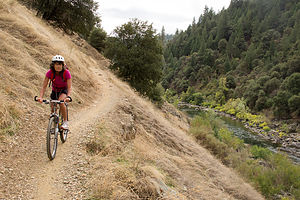 Lolo Biking the Lake Clementine TrailWe really had no plans from here, other than flying out of SF Airport in 5 days – very unlike my usual anal-retentive planning. Now that we weren’t racing back and forth across the country every vacation, our travels were taking on a different feel, more relaxed and spontaneous. Also, since we knew we would be coming out this way again and again to see the boys, missing something this time was not a big deal, as we would just hit it the next time. I think we are going to like this new toned down pace.
Lolo Biking the Lake Clementine TrailWe really had no plans from here, other than flying out of SF Airport in 5 days – very unlike my usual anal-retentive planning. Now that we weren’t racing back and forth across the country every vacation, our travels were taking on a different feel, more relaxed and spontaneous. Also, since we knew we would be coming out this way again and again to see the boys, missing something this time was not a big deal, as we would just hit it the next time. I think we are going to like this new toned down pace.
Herb came up with the idea for this stop. He loves river running, and the American River, which flows through the Auburn State Recreation Area, is supposed to be one of the best places in California to do that. This time of year was wrong for that, not enough water flowing, but we thought we could at least check it out for the future, and besides, Auburn had lots of other recreational opportunities that are good all year round, such as mountain biking and hiking.
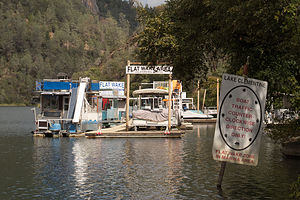 Lake Clementine MarinaWe found the Auburn Gold Country RV Campground through a search on Google Maps. The owner was extremely helpful in providing us with trail maps and mountain biking suggestions in the nearby Auburn State Recreation Area. That night we relaxed by the campground pool, reviewing the trails, and making our decision for the next day’s adventure.
Lake Clementine MarinaWe found the Auburn Gold Country RV Campground through a search on Google Maps. The owner was extremely helpful in providing us with trail maps and mountain biking suggestions in the nearby Auburn State Recreation Area. That night we relaxed by the campground pool, reviewing the trails, and making our decision for the next day’s adventure.
The directions for the trailhead for the lake Clementine Trail were extremely detailed, but we still screwed up and found ourselves biking for a mile or so down the wrong trail. Finally realizing we had made a mistake, we rode back to the car, remounted our bikes on the rack, and started all over again. I think the mix-up was that there is both a Foresthhill and an Old Foresthill Road.
Anyway, we finally found the correct trailhead and spent the morning on a really nice ride atop the riverbank of the North Fork of the American River. There were a few places, however, where the trail narrowed and dropped off much too sharply for my comfort level, so I got off and walked the bike a few times to avoid plunging into the river.
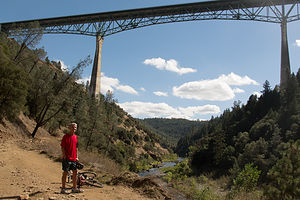 Herb Biking the North Fork of the American RiverThe trail map was very detailed and pointed out some nice stops we would have missed along the way, such as Clarks Hole. Without knowing that this stop would be in ¾ mile, we would have missed the short, steep side trail down to a pool and a sandy beach. The trail was much too steep for bikes, so we left them on top of the riverbank and walked down. It was a lovely spot, popular for swimming in the summer, but a bit too chilly now.
Herb Biking the North Fork of the American RiverThe trail map was very detailed and pointed out some nice stops we would have missed along the way, such as Clarks Hole. Without knowing that this stop would be in ¾ mile, we would have missed the short, steep side trail down to a pool and a sandy beach. The trail was much too steep for bikes, so we left them on top of the riverbank and walked down. It was a lovely spot, popular for swimming in the summer, but a bit too chilly now.
Continuing upriver, the trail transitioned from a narrow, bumpy dirt trail to a shaded, smoother dirt roadway, which was once the old stagecoach route connecting Auburn with other gold rush camp towns in the mid to late-1800s. The better surface would have made the ride easier except for the fact that now it began to climb quite steeply and continued to do so until we reached Lake Clementine Road, where the trail officially ends. From there we followed the paved roadway for about ¼ mile to an unmarked side trail on the left, which led to a great view of the water cascading over the North Fork Dam, on the southern end of the lake, and the reason this lake is here in the first place.
 Broad Street Nevada CityThis is an out and back ride, so from there we turned around and went back from whence we came, enjoying it much more, as most of it in this direction was downhill.
Broad Street Nevada CityThis is an out and back ride, so from there we turned around and went back from whence we came, enjoying it much more, as most of it in this direction was downhill.
There was still a lot of time left in the day, so we decided to take the 25-mile drive up Route 49 to Nevada City, another historic Gold Rush boom town, which was also a nominee for Outside Magazine’s 2012 ”The Best Town Ever” award.
I do have a soft spot for quaint old historic towns and this one was a gem. We picked up a Walking Tour Map at the Chamber of Commerce and wandered up and down its quaint streets, which really do have the feel of an old mining town.
It’s hard to believe that this was once the third largest city in California and home to 10,000 boisterous souls --miners, saloon keepers, shopkeepers, prostitutes, and every other provider of necessities for men with new found riches in their pockets. Today it’s a quiet little town of 2,800 residents, who have had the smarts to recognize that their new source of wealth is the town’s remarkable history and charm, and they have done an excellent job at restoring and preserving that. Today the entire downtown area is listed as a national historic landmark.
Still, I would have to say that although it’s a nice place to visit, I wouldn’t want to live here. It's just a little too small and out of the way for me.
Description
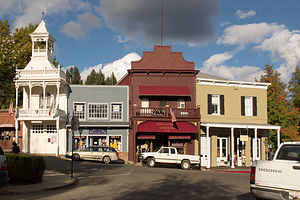 Main Street Nevada CityAuburn is located about 30 miles northeast of Sacramento via I80. Considered by many to be the adventure capital of California, it is home each year to the Western States Endurance Run/Ultra Marathon and the grueling Western States Endurance Ride. It is also rated one of the best places to live in Northern California.
Main Street Nevada CityAuburn is located about 30 miles northeast of Sacramento via I80. Considered by many to be the adventure capital of California, it is home each year to the Western States Endurance Run/Ultra Marathon and the grueling Western States Endurance Ride. It is also rated one of the best places to live in Northern California.
Like many other cities in California, Auburn’s start was triggered by gold. However, unlike most of the other boom and bust Gold Rush towns, it survived by becoming a major supply and trading center. After a series of fires in the 1850s destroyed many of the wooden buildings in town, the townspeople rebuilt them in brick. You can see many of these restored buildings when visiting Historic Old Town.
While miners originally came to this area to pan for gold in the American River, today outdoor enthusiasts flock to the area to enjoy its recreational treasure – the Auburn State Recreation Area, which encompasses 35,000 acres along 40 miles of the North and Middle forks of the American River. The confluence of the North and Middle Forks is one of the most popular areas for swimming, fishing, and access to the many mountain biking and hiking trails in the Auburn SRA. Also, the American River is a premier river running destination with class II, III, and IV runs.
